

When I wrapped up the main article, I wasn't sure I was going to do this. There was more I wanted to say, but I'd already dedicated half a year to the topic and figured it was time to, I dunno, finally finish that Spamton comic? At the very least, I should wait for the next Deltarune release, which has since been changed to just Chapters 3 and 4.
Halfway through Doom Patrol I said to myself "Okay, I have to do a followup."
If you've somehow missed them, here's links to the previous two essays:
Knight of the Fox
Son of the Knight of the Fox
The first one is optional but recommended, but you really need to read the second one before continuing.
At the time of the original Animal Man/Deltarune article's publication the only other works of Morrison's I had read were All-Star Superman and Flex Mentallo, I was about halfway through Crisis on Infinite Earths which wasn't written by Morrison but is still important to Animal Man and DC history altogether, and I had just started Doom Patrol. I've since finished both, and also read Arkham Asylum, Joe the Barbarian, We3, The Multiversity, and Supergods, as well as The British Invasion by Greg Carpenter because why not. Spoiler warnings for all these books, obviously. Honestly, Flex Mentallo is only four issues long and Arkham Asylum is 100 pages (it lists 228 but half of that is production notes) so if you're concerned about spoilers those two aren't much of a time investment.
Supergods is a combination history of American comic books, autobiography of Grant Morrison, and analysis of how superhero comics reflect humanity and classic mythology and honestly you can get the gist of it from that philosophy of Grant Morrison video, The British Invasion is a look at the careers of Alan Moore, Neil Gaiman, and Grant Morrison, and We3 is about a government project to turn house pets into weapons and doesn't have much in common with Undertale or Deltarune besides its ability to absolutely destroy you. I won't be dedicating sections to any of these books nor Crisis on Infinite Earths, but will reference them where relevant. However, I got a print copy of Supergods so I'll have to type out passages rather than screengrab them.
Going into this I'd already decided to hold off on The Invisibles and The Filth because The Invisibles sounds like an absolute monster to piece together and general consensus seems to be that The Filth is one of Morrison's weaker books. But as I read The British Invasion I kept discovering new books I'm going to have to look into; Sebastion O takes place in a computer simulation, The Mystery Play is about a pair of angels trying to overthrow God, and Final Crisis explores metanarrative and comics as alternate realities using Superman and Batman instead of some joke character nobody cared about and got Morrison slammed with death threats from angry fanboys. But I have to set some kind of safety line here or get lost in this rabbit hole. I'll be reading these books down the line, probably after a break from Morrison's stuff, but when I talk about them depends on if Deltarune Chapters 3 and 4 release this year and if I feel like waiting if they don't.
As I write this Animal Man is no longer available on Kindle Unlimited (Joe the Barbarian is but I don't know how long that'll last). Keep checking to see if it returns or gets discounted, back at Christmas Amazon was having a huge sale on DC books and you could get the whole series for just $6.
And as a reminder, when I refer to Fox being "the Knight" take it as shorthand for "the ultimate baddy toying with everyone." Maybe Fox is literally the Knight. Maybe the Knight is Kris under Fox's control. Maybe the Knight is a second character who's being controlled by Fox alongside Kris (after all, each player in chess has two knights). Maybe each Dark World is created by a different possessed character like Kris in the ending of Chapter 2 and any character Fox takes over becomes "the Knight" like how any Aeon Yu Yevon takes over becomes Sin.
But let's start things off with a question I'm sure you're wondering.
The first and biggest reason I don't believe Fox is the Knight is the whole "Gaster created Deltarune" thing. Fox being the Knight acknowledges him as Deltarune's creator, buuut we're supposed to pretend Gaster is Deltarune's creator, right? Maybe you could argue there is a Godhand/Skull Knight relationship going on between Fox and Gaster, but Gaster is Deltarune's creator and Fox is the one meddling with his work but... no. As soon as you bring Fox into the story, all suspension of disbelief goes out the window and you acknowledge him as Deltarune's literal creator. So yeah, the ideas of "Gaster created Deltarune" and "Fox is the Knight" are not compatible. Which again, in conjunction with "the player is the game's true villain even if they play pacifist" I do not understand what Fox is getting at besides calling me a prick for playing his game while making Gaster take the blame for creating it.
Second, Fox clearly does not like to make public appearances. Any time he has an interview or an orchestra performing his music, he has a toy of the Annoying Dog in his place. For that reason, I cannot wrap my head around him literally putting himself in his own game. This is why I proposed the alternative of making the Annoying Dog the Knight, which... for the sake of Fox's privacy would be an acceptable compromise, but it has a couple problems I'll talk about when I'm done here.
Before I go on I need to talk about To Boldly Flee, which I briefly mentioned in the first essay. If you don't know, To Boldly Flee is the third Channel Awesome movie, fourth if you count the AVGN crossover, and it ends in such a similar way to Animal Man that I swear Doug Walker either read Animal Man himself or heard about if from Linkara. But unlike Deltarune I've actually been able to find ONE other person comparing To Boldly Flee to Animal Man.
The story of To Boldly Flee concerns a giant rift in space called "the Plot Hole" and the Channel Awesome crew turning the Nostalgia Critic's house into a spaceship (just go with it) to investigate it. At the end of the movie, the Critic flies his car into the Plot Hole (I SAID JUST GO WITH IT) and is teleported to... Doug Walker's living room, as he's writing movie's script. There, Walker waxes on about how the Nostalgia Critic has become more than Walker ever intended for him to be, and it was time for the Critic to make his own choices in life... or something, this is after three hours of Star Wars references, I was only half paying attention at that point.
So why did Animal Man ending with the main character meeting the writer work while To Boldly Flee didn't? For starters, To Boldly Flee was just a godawful movie, and nobody was buying this philosophical bullshit about the creation eclipsing the creator after sitting through three hours of JesuOtaku's obnoxious Radical Ed cosplay and the Judge Dredd battle that wouldn't fucking end. Second, Morrison and Buddy are two completely different individuals while Doug Walker is basically talking to himself, so the interaction is far more arrogant. Third, Morrison and Buddy's conversation is quiet and apologetic, while Doug Walker's speech comes across as "I'M A GREAT WRITER, MY MUM SAID SO." Well, at least until he shows some self-awareness by having the Nostalgia Critic snap back at him with "Okay, your story sucks!"
Finally and probably most importantly, To Boldly Flee's ending comes out of nowhere. Animal Man consistently eroded the fourth wall with the brush at the end of "The Coyote Gospel," its cutaways to Morrison working on their computer, the Mad Hatter raving about "some cheap hacking writing our lives," Buddy seeing out of the comic, and the entire Overman battle. The ending wasn't even the first time we saw Morrison, not counting the scenes of hands at a keyboard. About halfway through the book Highwater has a dream of a mysterious figure in a coat walking in the rain.

People reading in 1989 had no idea who that was, but looking at it after reading the conclusion we realize it's Grant.
And just to vent, Greg Carpenter talks about this scene in The British Invasion but for some reason he keeps calling Highwater "Hightower." For crying out loud, his name is literally a reference to the water of the higher reality.
To Boldly Flee has no thematic buildup, no foreshadowing, it's just three hours of sci-fi movie parodies and commentary on the business of movie production gutting the artistry then BOOM Doug Walker out of nowhere! So the movie doesn't so much break the fourth wall as slam headfirst into it and break its own neck against it.
What I'm saying is when something is more courageous that also means it's riskier, and Fox making himself the Knight carries the risk of sending the entire project straight up his own butt. Heck, I've seen people call Grant Morrison a pretentious twat for making themself the, for lack of a better term, "final boss" of Animal Man, completely missing the entire point of the book. For the sake of discussion let's say Fox was inspired by Animal Man. When it came time to plan the game's ending he may have said to himself "I ain't no Grant Fuckin' Morrison," and made Gaster the game's creator and our hypothetical "Raha" the Knight to keep the game away from his butt. His intent isn't to shame the player for manipulating his characters while using Gaster and Raha to wash his hands of his own manipulation - or at least I hope not - that's an unintentionally hypocritical side effect of a more benign reason.
Finally, while logically, narratively, and thematically Fox is the most fitting choice for the Knight, he may very well be the least exciting choice. Morrison opening the door at the end of Animal Man #25 was honestly a bit of an anticlimax if not an outright "screw you" to the reader, but that came after only two years of buildup. Deltarune's already been in development for eight years and if it continues as its current rate, it's going to be another decade before we get the conclusion. I don't think taking longer to develop than Duke Nukem Forever and ending with a "Haha, it was me all along!" prank is going to sit well with a lot of people.
However... is it a confirmed fact that Gaster is supposed to be Deltarune's creator? Or is that just a deep-seated fan theory and he's doing a damn good job being the decoy Fox instructed him to be? Maybe Fox has the confidence that he can pull off gaming's Animal Man instead of winding up with gaming's To Boldly Flee.
And all things said, there is one thing that does point to Fox being the Knight: he has no reason to keep quiet about Grant Morrison and Animal Man otherwise. If Fox is not the Knight then there's no reason he wouldn't be able acknowledge Morrison's influence on him, and if asked about Animal Man's ending twist say "Yeah, but I'm not the Knight." Well, not a good one, but I seriously hope Fox has not been spending the last eight-and-a-half years using his audience's disinterest in so-called "capeshit" to pass off Morrison's ideas as his own and garner international acclaim, especially among the Japanese who notoriously do not give a fuck about western comics, while letting his fans shit all over creators that took inspiration from him from Yahtzee opening his review of Immortals Fenyx Rising by dismissing every game that took inspiration from Undertale as a loveless cash-grab that could never be half as interesting as Undertale and calling for an "Undertale ripoff" Steam tag in his Everhood review, to this jackass and frankly everybody who sided with MatPat in the Heartbound controversy arguing that MatPat was doing games like Heartbound and Everhood and their creators a favor by putting them in Fox's shadow because "Undertale wannabe" is the only thing those games could ever hope to be known for.
Of course, that assumes Fox was inspired by Animal Man. But the only doubt I have on that is the whole "never taken Fox to be a fan of comic books" thing and I can't think of any reason he wouldn't be into them, either. I'm sure he's at least thumbed through a Spider-Man or Donald Duck comic. And the more of Morrison's work I've read, the more convinced I've become that Deltarune wasn't just inspired by Animal Man, but Morrison's entire philosophy.
For starters, it would turn Deltarune's climax into the Dog ending from Silent Hill 2.

But more important, even though we know the Annoying Dog is supposed to be Fox's stand-in, or what Morrison calls a "fiction suit" in Supergods, it's still an obfuscation of Fox. I briefly brought up Flex Mentallo, but didn't mention Wally Sage is a self-insert/fiction suit of Grant Morrison. The Annoying Dog being the Knight would be like if Wally Sage answered the door at the end of Animal Man; it's like a kid blaming their hand puppet for breaking a lamp. If Fox wants the Annoying Dog to pop out of the bunker at the end for privacy reasons, he would have to make it clear he is the mastermind behind everything and is borrowing the Annoying Dog's body to speak through.
I don't know how to solve the "Dog ending from Silent Hill 2" problem, though. Pass it off as an homage?
As I mentioned earlier, Flex Mentallo is only four issues long so there's not a heck of a lot dig through. But it's a fairly convoluted four issues, taking place across three layers of reality that blur into each other as symbols from lower realities appear in higher layers, and characters appear to travel between layers. And it could even be four layers of reality, or six if you count our reality and Morrison's fifth dimensional imps that write our world. For discussion's sake, let's focus on the three main layers in the book and call them "the heroes' reality," "Wally's reality," and "Flex's reality."
Flex Mentallo, the character, is an homage to the Charles Atlas advertisements of Golden Age comics, and his power is that he channels psychic powers by flexing his muscles, hence his name being derived from "Flex" and "Mental." Flex Mentallo, the comic, is a comic about comics, with each issue meaning to represent one of the four major periods of comic books: the Golden Age, the Silver Age, the Dark Age, and what Morrison at the time believed would be The Renaissance. But reading Supergods reveals it's also heavily autobiographical of Morrison; Wally's father taking him to bookshops with comics depicting skeletons dropping bombs on cities is lifted from the anti-war magazines Morrison's own father would bring home, and Wally receiving a stack of comics from his aunt while recovering from an operation is straight out of Morrison's own battle with appendicitis. It's also a great big middle finger to Watchmen, which Morrison was one of the earliest critics of.
According to Supergods, which was published in 2011, Morrison has warmed up to Watchmen but still has issues with it, namely that, in Morrison's words, "for [the] plot to ring true, we [are] required to entertain the belief that the world's smartest man would do the world's stupidest thing after thinking about it all his life." I personally haven't read all of it, it's been on my to-do list for ages and I got a few issues into it years ago, but what's always irritated me about Watchmen is the way it's constantly weaponized against comic books by people who don't actually read them. "Yeah, comic books can be more than Spider-Man punching the villain of the month in the face. There's Watchmen. And The Dark Knight Returns. Oh yeah, and V for Vendetta. That's it."
Anyway, Flex Mentallo. I summarized it in the Animal Man/Deltarune essay, but admittedly had to simplify it for space reasons. The first three issues switch between two realities, that of Flex Mentallo and that of his creator, Wally Sage. Wally spends most of his time slumped over in an alleyway, using his cell phone to talk about comic books to a suicide prevention hotline while dying of a drug overdose, while down in Flex's reality everyone's screaming about the end of the world and wondering what happened to all the superheroes despite several supervillains still hanging around. The sole remaining superhero, Flex Mentallo, takes it upon himself to investigate the connection between the alleged end of the world, the missing superheroes, the sudden appearance of his old crime-solving partner the Fact, and a terrorist organization known as Faculty X.

By the fourth issue Wally learns there is, or rather was a reality above his own. The superheroes of his comic books were in fact his world's creators, and when the heroes' reality was on the verge of destruction they made themselves fictional in Wally's reality. Wally realizes this timeline is just one of many possibilities, and there's one reality where he swallowed a fistful of drugs, and another, equally valid one where he swallowed a fistful of M&Ms. Now he has to decide which of those two realities this one will be, but he's so dead inside he needs something - or somebody - to convince him to choose the M&Ms.
By following both the Fact and Faculty X, Flex finally finds himself on the moon, facing down some Mac Tonight look-a-like who claims to have created Flex's world for his amusement and now intends to destroy it for his amusement. He's also the one responsible for the disappearance of the other superheroes, having imprisoned them all in the dog star, Sirius, which is a reference to the dog carcass line from Watchmen. He also reveals Faculty X is the Fact, "spread" across time and space.

Which sounds like somebody else being "shattered" across time and space.

Most unsettling, the Man in the Moon can force the inhabitants of Flex's world to do whatever he wants: turn themselves inside out, shoot themselves in the head, and they cannot resist him. But with the help of a reformed villain with illusion powers, Flex unmasks the Man in the Moon and reveals him to be...

... teenage Wally going through his "everything is shit" phase. Reminder that Wally is a self-insert of Morrison.
But why's Wally disguised as the Man in the Moon? Because when he was a child, he'd read his comics by a night light in the shape of the Man in the Moon.

There's that thing about lost childhood trinkets that popped up in Animal Man. And Deltarune, with Kris' lost headband.


So, here's what I think is going on: Moon Man/Wally banishing all the other heroes to Sirius was a metaphor for Wally deciding he was too old and mature for silly superhero comics, though in his cynicism he left all the supervillains behind. But Flex was so important to Wally that he couldn't bring himself to banish him with the rest of the heroes, which is why he's the only one left. The Fact learned about Wally's decision to end his own life, which would take their world with him and tried to snap him out of it, only to get his temporal shit kicked in. The Fact was leading Flex to Wally knowing that, as Wally's favorite creation, he had the best shot at convincing Wally to keep living.
As to how the Fact got out, maybe as another one of Wally's creations, his prison wasn't as strong as the heroes Wally didn't create and he was able to slip out?
While Flex Mentallo is about comics, any form of fiction can help us find the comfort to get through tough spots in life. But Wally became too obsessed with his comics and lost track of what was going on in the real world like his girlfriend dumping him, and rejecting comics altogether was him overcorrecting (in Supergods, Morrison talks about the turmoil they went through after their parents divorced following their father's affair, and the feeling of magic going out of their own life). But without his dreams, he's being suffocated by reality. He, and everyone for that matter, needs both.
I'd say Wally Sage makes a good case study on what makes a good self-insert. A good self-insert is used to tell an autobiographical story, but create enough of a separation between the author and the character that the reader can more easily project themselves onto the character, see also Charlie Brown. A bad self-insert is effectively a clone the writer uses to go down on themself, living out power fantasies, beating strawmen, and having other characters tell them how awesome they are. Another way to put it is a good self-insert exists for the reader's benefit, while a bad self-insert exists for the writer's benefit.
After Flex saves Wally and thus his entire world by convincing Wally to choose the M&Ms, the comic shifts up a reality, to a page of Flex calling out to Wally "I'll be right here if you need me."

And how does Ralsei calm Kris down if you let them freak out after the Spamton NEO fight?

And it turns out the person Wally had been talking to over the phone this whole time has been the Fact.

It sounds like this brings up a third possibility for Gaster and Fox's relationship: Gaster is like the Fact, having been shattered across time and space by Fox, and is now using his displacement to his advantage and try to guide the characters to Fox in an attempt to... uh... save him? From what? I just don't think this works with Deltarune's themes. Truth be told it reminds me more of the Asriel fight in Undertale, with Wally as Asriel and Flex as the player; the former is a mad god who's ready to end the world in a fit of nihilism, the latter has to pull him out of it.
(Okay, so the Valentine's Day newsletter contains randomized Valentine's Day cards and one of them appears to be from Gaster, talking about how he was supposed to be helping somebody, but has forgotten who and why? So maybe he is trying to help Fox? Or somebody, at least?)
Side note, while The British Invasion was generally an interesting read, Carpenter makes some baffling mistakes in it. I already talked about the "Hightower" thing but was willing to pass that off as a buggy autocorrect. But when he's talking about Flex Mentallo he keeps calling the Fact Flex's villain and arch-nemesis. But Flex literally calls the Fact "a friend" and "a crime-fighter" because as Morrison states in Supergods Flex and the Fact weren't enemies, they were partners. Maybe they had a friendly rivalry as to who could kick more criminal ass, but that was the extent of it. Also, Carpenter says something about Wally leaving the phone booth and bumping into the Fact, but as we clearly see here the Fact was the one in the phone booth while Wally was on his cell phone puking his guts out in an alleyway GYAAAH.
A recurring theme of Deltarune's hidden bosses, besides them both going insane after realizing they're just characters in a video game, is that they're based on things you find at an amusement park: Jevil is a clown fought on a merry-go-round, while Spamton NEO is a puppet fought on a dark ride. I joked about the book chapter's secret boss being a monkey at a typewriter, but apes and monkeys can be found at amusement parks. Or zoos if we consider all sites of childhood entertainment rather than limiting ourselves to amusement parks.
Another speculation I'm going to throw out so I can say I called it if it happens? One of the secret bosses is going to be a strongman. Whether he's a deliberate homage to Flex Mentallo or coincidentally a strongman depends on if Mex Flentallo warps reality by posing. I do hope Fox knows what he's doing when he unleashes that on the world because good Lord, can you imagine the Rule 34 of a Deltarune character based on Flex Mentallo?
Speaking of which, I'd like to point out the name of the, uh, "establishment" where the superhero BDSM orgy takes place:

Morrison originally created Flex Mentallo and Wally Sage for Doom Patrol. Some parts of their backstories are the same, others aren't, so unless I'm missing something (which is likely, I am kind of an idiot) Flex Mentallo Flex and Wally and Doom Patrol Flex and Wally are another instance of alternate versions of the same characters.
Confession time: I have never read Homestuck. I tried to several times but could never get very far before I put my head on my desk, asked "What the fuck am I reading?" and gave up before my skull split in twain and released a flock of doves. Just as well because Homestuck has more words than the Bible and a chunk of it was lost alongside the Flash engine, meaning the thing is even more unreadable now. I've accepted it was something you had to be there for.
One day while doing some grinding in World of Warcraft I put on a podcast of a couple guys talking about it, and the whole time I kept asking myself "What the fuck am I listening to?"
You've got this kid whose artificial father is The Question or something? And this band of kids who play a video game that summons meteors that destroy the world, and now have to force feed a frog to make it explode and form a new universe? But one of them betrays the others and throws her zombie dog, or maybe it was the Cthulhu/cat hybrid (or was it a Cthulhu/dog hybrid and a zombie cat?) into a hole to obtain godlike powers? And there's this inventory system where you have to name your stuff so the letters encrypt into certain numbers to fill the corresponding slot? And there's trolls that reproduce by spitting into buckets - at least I hope it was spitting and not doing something else into those buckets - which led to some of the cringiest shit you've heard of at comic conventions? Was this comic written by a random word generator?
Okay, before anyone blows out their vocal cords yelling at their computer screen, yes, I know Toby Fox wasn't the creator of Homestuck, his friend Andrew Hussie was and Fox did music for it. I don't know how close Fox and Hussie still are after all the money Fox threw into the Hiveswap money pit and Hussie suing that YouTuber over a video he admitted to never actually watching but honestly, that is absolutely none of my business and not what you're here to read about.
Why am I bringing up Homestuck now? Because Doom Patrol has that same "written by a random word generator" feel to it. This is a comic where one of the antagonists is a guy who was paralyzed and locked up in a sensory deprivation chamber until he turned into Henri Matisse's "Icarus" and now recruits people with stupid sounding but OP superpowers such as "every power you can't think of" or "going completely unnoticed despite dressing like an absolute twat" into his Brotherhood of Dada. This is a comic where a sitcom husband and his band of bug men who can only speak in acrostics of "nowhere" (i.e. "No obstruction will hamper eminently righteous endeavors.") try to kill a sentient crossdressing street named Danny who can teleport anywhere in the world. This is a comic where this guy was born with a prophecy about the Demaker tattooed all over his body, and is now being hunted by cultists from a city in a snowglobe that enter our world through a wound in a guy's hand who is identified by soaking a phone book in Sprite that's been blessed by a priest and I have to stop here because I can hear the birds pipping at the inside of my head again.
By the way, I'm only going to be looking at the comic here. While the TV show is heavily based on the Morrison run there are differences, one of the biggest being that the show is self-aware while the comic keeps the fourth wall intact... well, save a couple little hairline fractures I'll mention. It's almost like the show was trying to combine Animal Man and Doom Patrol. There are many other changes - Cliff was mangled in the NASCAR accident in the comic while in the show he survived and was mangled in a later accident, Rita is dead in the comic and Cyborg isn't in it at all, the show uses the original Negative Man instead of the Larry/Eleanor fusion Rebis, Jane is an adult in the comic and early 20s at most in the show, Mr. Nobody doesn't have a personal vendetta against Caulder in the comic (in fact, I don't think the two ever meet in the comic), Danny is male in the comic and nonbinary in the show, and so on. Some things are probably from the Gerard Way or other non-Morrison runs I haven't gotten to yet, like I know Animal-Vegetable-Mineral Man is from the original silver age Doom Patrol, but the show itself acknowledges you're there because of the Morrison run. And you're here to read about similarities between Deltarune and Doom Patrol, not the Doom Patrol comic and the show. But above all, the show debuted in 2019, a year after Deltarune Chapter 1 released, so if one of them inspired Deltarune it's going to have been the comic. Unless the show is what fucking inspired Fox to fucking add all the fucking swearing to Chapter 2.
Seriously, if you've ever wanted to hear Brendan Fraser drop F-bombs in a voice like he's got a metal bucket on his head, Doom Patrol's got your bizarrely specific curiosity covered.
(Hi, Future Codie here. When I originally posted this in February 2024 there was a YouTube channel that had clips of the Doom Patrol show, but it's since been taken down. I found DC's own official channel has the first three episodes, but the framerate is choppier than the removed footage. Still, I don't have to worry about this version getting removed and you get to enjoy Mr. Nobody calling out the Grant Morrison fans watching all the same. You can also rewind to the end of episode 1 to see what Mr. Nobody's talking about with the donkey fart)
Funnily enough, I managed to find a couple people comparing Deltarune to the Doom Patrol show, plus somebody who's repeatedly cited Spamton NEO and Cliff Steele among their favorite fictional robots. But the only instance I could find of somebody mentioning Deltarune alongside the comic was this tweet of somebody posting their fanart of Spamton and the comic version of Mr. Nobody.
Yes, "Cliff Steele." Go ahead and get the Space Mutiny references out of your system, I'll wait.
"Actually, I'm still hung up on the words 'sentient crossdressing street,' how does that work?"
Danny is full of shops for "manly" things like hardware and gun stores, but they have the frilly decor you'd expect from a flower shop or a fashion boutique.
And oh boy, Mr. Nobody. Mr. Nobody has got to be the most Toby Fox character not actually created by Fox ever. Look at him and tell me you couldn't picture him as the main antagonist of Deltarune's hypothetical music and art chapter:
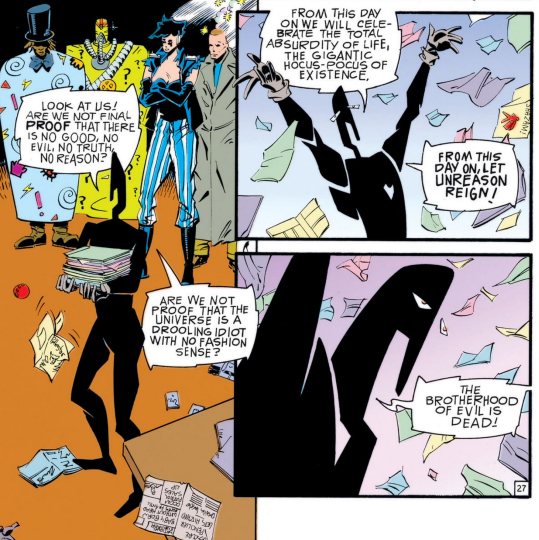
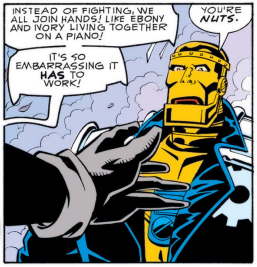


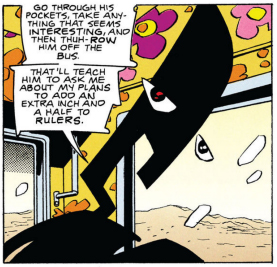

Yes, I'm pretty sure Mr. Nobody is talking about shoving that egg up that man's butt.
In his first storyline, he steals a painting and uses it to to absorb Paris by reading bad poetry to it. But the Doom Patrol and Brotherhood of Dada soon find out the Fifth Horseman of the Apocalypse (that would be Conquest for fans of The Binding of Isaac) is imprisoned in the painting, and their tampering with it has broken his seal so they defeat him by... okay, the resolution to this is so gloriously stupid I encourage you to read it for yourself, but I have a point to make so highlight for spoilers: using the power of friendship and Dadaism to turn him into a rocking horse. And in his second story he decides to run for President of the United States, so he steals the inventor of LSD's bicycle, uses it to power a school bus (which is itself based on Ken Kesey's own adventures with LSD), and rides it around the country, making everyone along his campaign trail trip balls.
Dadaism, if you're wondering, is essentially shitposting taken to an art. The most famous example of it is probably that urinal with "R.Mutt" written on it. Yelling "Flibbity bloo bloo tomato pancakes" is Dadaism. You know how art generally tries to say something? Even if it's an abstract piece trying to convey "I'm angry" with a smashed up grill pit? The only thing any piece of Dadaism is trying to say is "because fuck you."
I originally compared Queen to the Time Commander in Animal Man but even I admit that was tenuous at best, based around little more than both's obsessions with bulbous glassware. But if you told me Queen was based on a Grant Morrison character and asked me to guess which one, it'd absolutely be Mr. Nobody. He's equal parts silly and psychotic and wants to take over the world, but only because he just wants everyone to have fun.
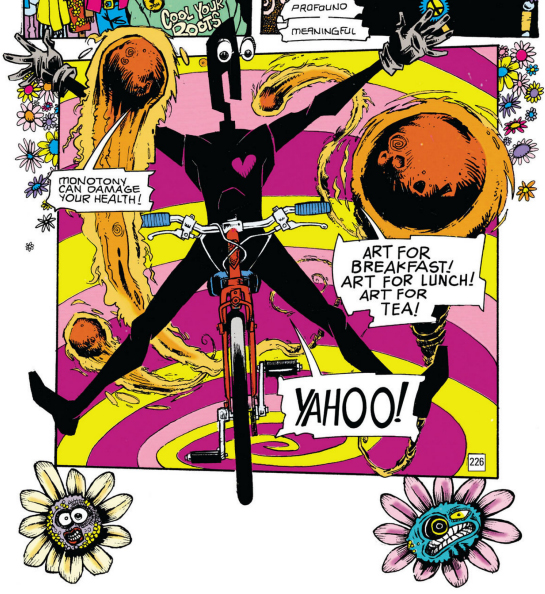
He has a bit of Jevil's "I can do anything!" attitude, as well.

He even looks like something out of Deltarune and if you inverted him you could drop him into Undertale. In fact, Doom Patrol is full of weird character designs that if turned into sprites would fit perfectly into Deltarune; an old man with a lava lamp for a head, Agent "!" who has the tackiest suit ever and a bird cage containing a little airplane for a torso, whatever the hell is going on with Dorothy's imaginary friends, a commando gorilla pushing a disembodied brain in a jar around in a baby carriage, a guy with nicknacks from a junk drawer for a face surrounded by copies of his original face, a, uh, mouth man with a thumbprint for a head? The Men from N.O.W.H.E.R.E kinda look like Swatchlings if you squint a bit, and could turn them purple.


Doom Patrol doesn't play with the fourth wall, but it does share Animal Man and Flex Mentallo's themes of alternate worlds and dreams becoming reality. I mentioned how the first major storyline has the Doom Patrol obtaining the encyclopedia some scholars wrote for their made-up city, Orqwith, which caused Orqwith to become real and start devouring the real world. Well, I slightly misunderstood that, it's actually a book about some scholars creating an encyclopedia for their made-up city, Orqwith, which caused Orqwith to become real and start devouring the real world... which caused Orqwith to become real and start devouring the real world.
This comic is completely batshit bonkers.
Turns out, most storylines either have the Doom Patrol going into some pocket dimension or alternate reality or other world within the world which ends up destroyed or at least closed off by the end, or another reality invading theirs. Orqwith, Mr. Nobody's painting, that city in a snowglobe, the palace of Jack the Ripper reimagined as a masked man who draws power from the pain of his museum of pinned butterflies, at one point Cliff enters the sprawling metro line that's Jane's mindscape, and Albert Hofmann riding his bicycle on his first LSD trip turned it into a conduit to the fantastic which is why Mr. Nobody was so interested in it.
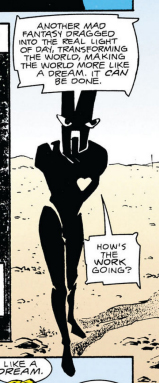
Why does Mr. Nobody's soliloquy there sound so much like a Dark Fountain being opened?
Two characters possess psychic powers that, rather than allowing them to move objects without touching them or read minds, allow them to manifest their dreams into reality. One is Wally Sage, Flex's creator. The other is Dorothy Spinner who for some reason has a monkey's face, giving her the appearance of a Planet of the Apes extra in Wizard of Oz cosplay. Given her power to make her dreams real, I'm sure she's supposed to be another reference to the Infinite Monkey Theorem, but I don't believe any story reason is given for her appearance.
One of the longest arcs has the Doom Patrol getting involved with a war between these, uh, spider/monolith/hamster ball men that reside in a pocket dimension called the Mesh and some yellow aliens which I'm sure aren't the same species as Trano and Zaarn, they just happen to look them them that reside in their own pocket dimension, the Kalidescape, whose leader, Huss, somehow talks in netspeak before netspeak was even a thing.
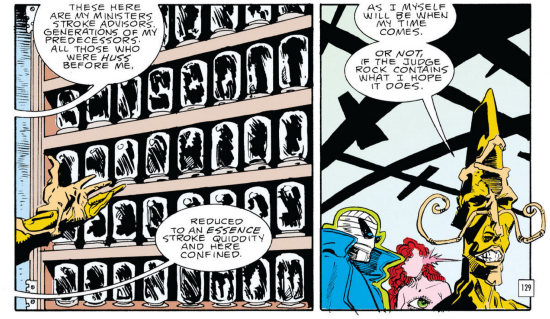
Yes, Animal Man has Foxy, Doom Patrol has Huss. Small world, huh?
Remember how I said that despite its numerous allusions to Christian iconography Animal Man never specifically mentioned an "angel," again, not counting Satan? Well, that's because the angels are hanging out in Doom Patrol.
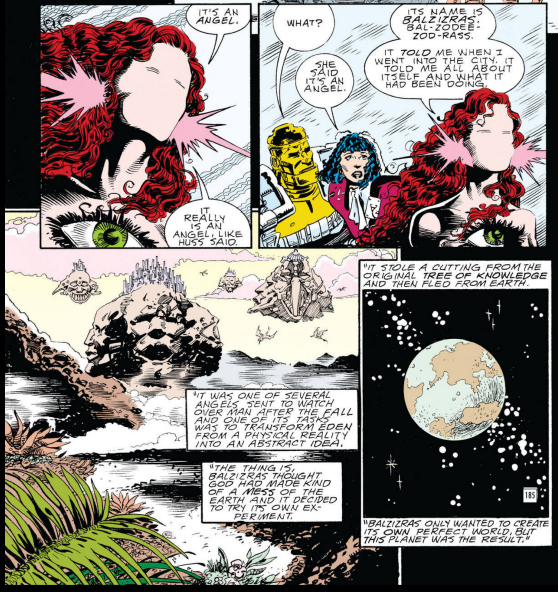
Rhea clarifying how "Balzizras" is pronounced is one of the hairline fractures in the fourth wall I mentioned earlier (the other is when, following Conquest's defeat, the painting starts to disintegrate illustrated by the comic itself shattering). When you're speaking you don't have to tell people how things are pronounced, the same way you don't have to tell them how things are spelled when you're writing. But since we're reading her words she says something that, in context, is just redundant. And it reminds me of Seam clarifying how their name is pronounced which, again, draws attention to the fact their words are printed rather than spoken.
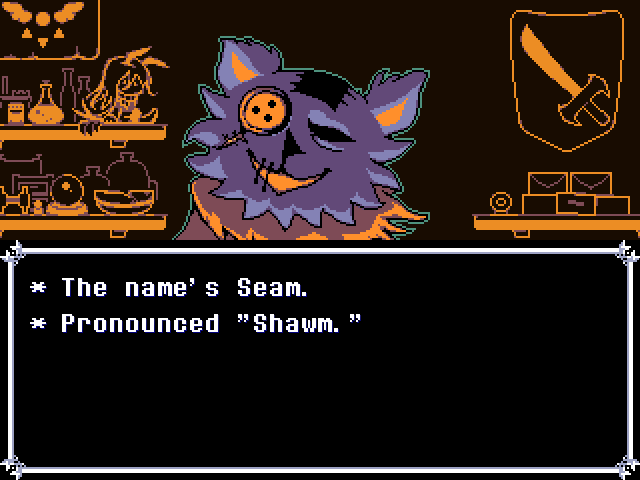
So, Balzizras is one of the angels God sent to clean up the Earth after Adam and Eve fucked everything up, but split off to make its own perfect world? What somebody could call the "Angel's Heaven?" One that also ended in disaster?
At the end of the book Danny reveals he's what's left of a dream world that modern people have lost touch with. Maybe even Eden itself, which the angels were tasked with moving from the physical world into the dream world. He now travels the world taking in broken souls and giving them comfort and entertainment ranging from an array of stores to his Perpetual Cabaret.

A gender-bending inorganic entity who just wants to provide the world with endless entertainment. I wouldn't go as far as to suggest Danny the Street inspired Mettaton, but if Fox were to say as much I wouldn't be surprised (and Danny the Street was himself inspired by Danny La Rue, a British drag queen).
And just like Undertale and Deltarune, Doom Patrol can go from madcap absurdity to pant-shitting nightmare fuel on a dime. For every silhouette man who just wants to doodle on Superman's butt, there's horror puppets puppeteering horror puppets.

I'd like to see if Fox has the stones to write into Susie's backstory where some asshole kid hanged her cat, so she asked the bastard lovechild of Baphomet and Cthulhu to disembowel the little shit and crucify him on a scarecrow's pole.
So what's Doom Patrol's connection to Flex Mentallo? Because Doom Patrol Flex and Wally don't seem to be the same as Flex Mentallo Flex and Wally. Flex is still a character from a comic Wally created as a child and made real with his psychic powers but Flex Mentallo Wally is a musician while Doom Patrol Wally is a dweeby college kid who gets abducted by government agents and imprisoned under the Pentagon when he stumbles upon a pair of sugar tongs in the shape of... uh... hands, which end up being a kind of tuning fork that enables communication with the dead.
I think what is going on is Doom Patrol obviously takes place in the surviving universe formed in the wake of the Crisis while the heroes' reality of Flex Mentallo was one of the alternate universes that was wiped out in the Crisis, where the superheroes used temporal shenanigans to survive in some kind of pocket reality. Think of it like Yu Yevon creating the Dream Zanarkand in Final Fantasy X before Bevelle sieged the city.
Flex's story centers around some horror being contained in the depths of the Pentagon which has haunted the phone lines since its creation. Long story short he tried to confront it, failed, and the Men From N.O.W.H.E.R.E. stripped him of his powers and reduced him to a dumpster diving amnesiac.

In other words, he's a shadow of his former self, living in garbage.

He eventually encountered Danny the Street, where he found sanctuary until the Doom Patrol's own battle with the Men From N.O.W.H.E.R.E. stirred his memories. With backup from the Doom Patrol, he takes another crack at the Pentagon and what do they find down there?
A fucking telephone god. That, uh, seems awfully familiar.

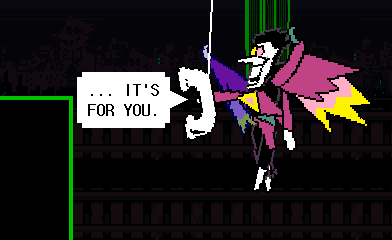
And its not a stretch to call it a god, this thing is called the Telephone Avatar, and an avatar is the incarnation of a god.
Wally restores Flex's powers with his dying breath, and after Flaming Katy (one of Jane's alternate personalities) destroys the sugar tongs to weaken it, Flex is able to further weaken the Telephone Avatar by flexing so hard he turns the Pentagon into a circle, and pleads to Dorothy to cut its lines to finish it off.

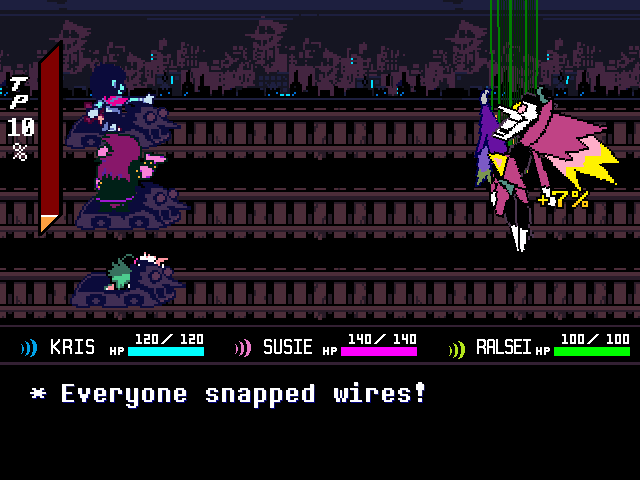
Well, she calls on... something to take it out, and it's hanging from its cables after the fight.


Did, like, Fox combine Crafty and Flex to get Spamton? For God's sake, the Telephone Avatar's palette is even the same as Spamton's: black, white, pink, yellow, and red with some gray lines to convey shape. And blue for the hard plastic's shine, I guess.
This made me think of something that I really hope I thought of before, but lost track of because it's so obvious. You know how the garbage noise from Log 17 comes through phones in Deltarune? In the early days of the Internet you had to connect through a phone line, and while connecting your computer would make a garbage noise similar, but not identical to it.
That "something" Dorothy called on to kill the Telephone Avatar is the Candlemaker, which to employ video game terminology is the final boss of Morrison's run on Doom Patrol. The Candlemaker was originally a formless manifestation of human anxiety over nuclear war, but it latched onto Dorothy, used a story she made up to combat her fear of the dark about a man who would make candles for frightened children to give itself form, and then used her psychic powers to break out into the real world. But when unleashed, the Candlemaker doesn't start burning down Manhattan and draw the attention of the Justice League, but starts tearing up the dream world instead. Because the best way to kill somebody is to first kill their dreams.

The Candlemaker also banishes Jane into some kind of rift, declaring "she's in Hell, suffering and suffering." Once the Candlemaker is defeated Cliff is able to find her with Danny's help, and it turns out her Hell is less "fire and brimstone" and more "tedium and dead dreams."
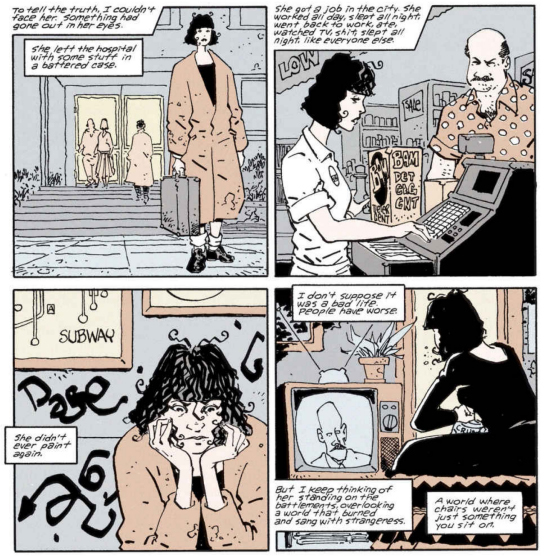
According to Ralsei's prophecy, the Lightners will survive the Roaring but their dreams, the Darkners, will be extinguished. And without their dreams the Lightners won't really live, they'll just exist, shambling aimlessly towards oblivion, lost eternally in an endless night.




But the Candlemaker isn't the Doom Patrol's final obstacle. Their leader, Niles Caulder, created this pool of nanomachines called the Think Tank with the ability to, well, theoretically do anything. Create food, cure disease, construct buildings, augment senators, basically make any alteration to the physical world you could imagine. He compares the nanomachines to neurons in a human brain, and we've already established that water is symbolic of potential, creativity, and imagination.
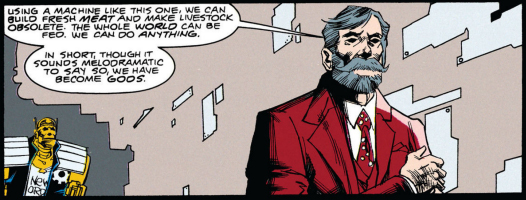
But just when the Doom Patrol and William Magnus, creator of the Metal Men, think they've averted Armageddon by the hands of the Candlemaker they find that before the Candlemaker ripped his head off, Caulder set the nanomachines to endlessly self-replicate and flood the world, causing a calamity that would force humanity to adapt or perish. Because fuck you, that's why.

Yes, it's a body of water with the power to make dreams reality, and now it's set to destroy the world. Doom Patrol has its own Roaring.

But wait, there's more! Cliff averts this disaster by interfacing with the Think Tank and overriding Caulder's catastrophe program from within, and one of the words used to describe the chaos of code and signals caught my attention.

I don't want to write an entire second novella about Doom Patrol and Deltarune and not just because Doom Patrol is almost twice as long as Animal Man (45 issues to Animal Man's 26), so I'm going touch on one more thing then move on. In any other case I'd call this tinfoil hat territory, but given all the other weird similarities between Morrison and Fox's work, I can't help but notice it; Caulder is obsessed with chocolate just like Chara was.
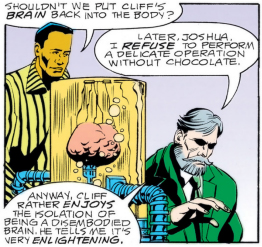

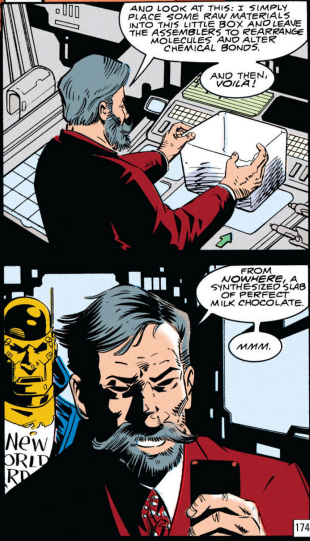
Kris too, I think? But kids are generally big on chocolate, so I'm kinda willing to chalk this up to coincidence.
So, uh, did anyone else not know Rocksteady's Batman: Arkham Asylum was based on a graphic novel?
I mean, I knew it was based on Batman, obviously, but I didn't know it was based on a specific Batman story - this one - until I read about it in The British Invasion. So if Deltarune really was inspired by Animal Man, it wouldn't be the first video game inspired by a Grant Morrison book.
Arkham Asylum is... odd. Batman goes to Arkham Asylum to stop an uprising among the inmates but when he gets there he finds the inmates just want to mindfuck him for a bit, he gets into a fight with Killer Croc, and after one last encounter with the Joker the book just kinda ends. When he first gets to Arkham he meets Ruth Adams, a psychiatrist who speculates that the Joker isn't actually insane but super sane, more aware of the world around him than others, and the only way he can cope with all the chaos is with more chaos.

Let's keep that in mind.
One of Batman's rogues' gallery he encounters is the Mad Hatter who doesn't appear in Batman: Arkham Asylum but Arkham City instead. When I first read that page in Animal Man of the Mad Hatter rambling about how they're all "words on a page"... well, my jaw dropped, because I truly could not believe what I was reading. But I also wasn't entirely sure it was the Mad Hatter because I didn't recall self-awareness being a thing with him. But no, Morrison just likes to make Tetch aware that he is only one of the things in somebody's dream.
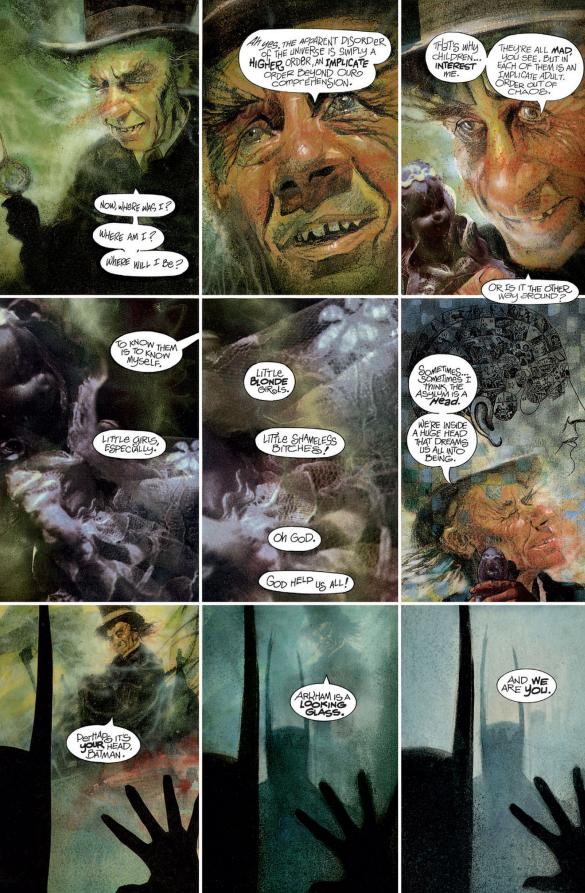
Yeah, uh, let's try to set aside the creepy pedophilic overtones there. If you saw this having never read Animal Man you'd think Tetch was only talking about the asylum in Batman's head and how his villains are all reflections of himself. But in conjunction with his appearance in Animal Man, plus his reference to the implicate order and the higher reality, it's hard not to believe he's also referring the asylums in Morrison and the readers' heads.
Another inmate Batman encounters is Maxie Zeus undergoing electroshock therapy.


Was really hoping to see something about the air crackling, here. See, Arkham Asylum isn't just about Batman's mental battle, but that of Amadeus Arkham who chose to pursue a career in psychology after watching his mother go mad, and converted his family home into Arkham Asylum. But the murder of his daughter kicked off his own descent into madness, ending with him being detained in his own asylum where he spent his final days using his fingernail to inscribe a spell on the floor and walls of his cell to trap "the bat." He then declares that the mad within Arkham Asylum are in fact the free, while those on the outside are the imprisoned.
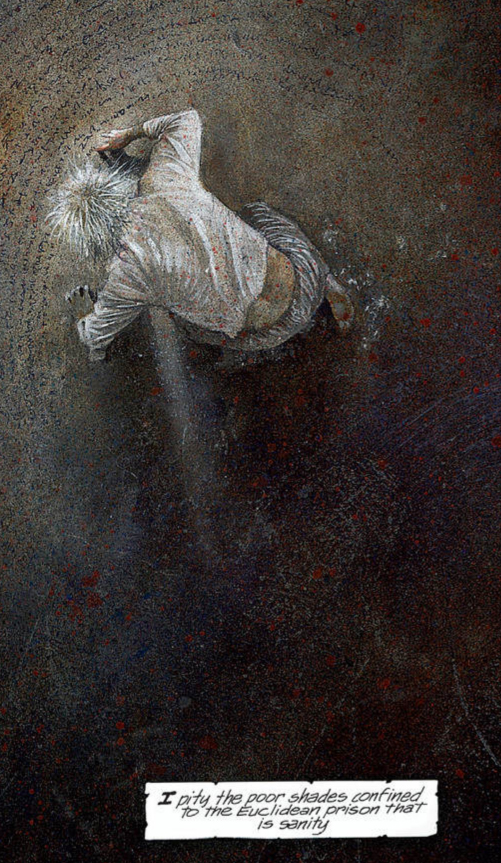
A sentiment shared by the Joker.

I seem to recall two other residents of facilities with alliterative names - "Card Castle" and "Pandora Palace" to be exact - for whom madness was freedom.
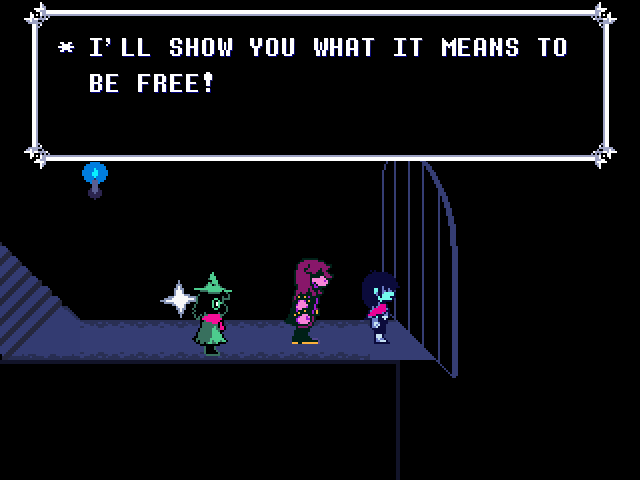

One of them is even a clown based on the Joker card, and the other wears high heels. I'd also like to remind everyone that one of Batman's monikers is "the Dark Knight."
Alright, I think I've finally stopped calling this "Dave the Barbarian."
Joe the Barbarian is about a diabetic kid who lives in single-parent home after his father was killed by a landmine in combat. One day while his mother is away, a storm knocks out the power just as Joe becomes hypoglycemic, and he slips into a fantasy world based on his surroundings where the darkness reigns supreme and he's the prophesized savior. So his toys become an army...

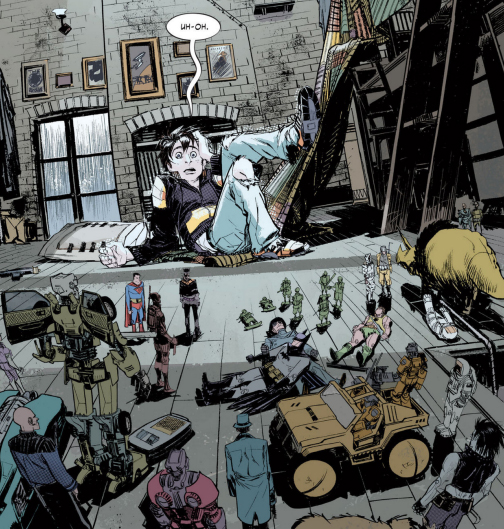
... his pet rat becomes Master Splinter...

... the bathroom becomes a pirate city...
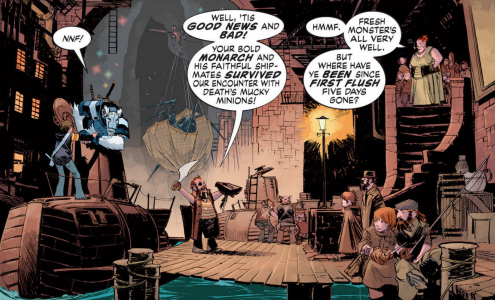
... the stairs become a mountain pathway...


... the soda he needs to get his blood sugar up becomes a mythical fountain....

... and his dead father becomes a legendary figure known as the Iron Knight.


Okay, so the only connection between diabetes and Deltarune I can think of is "Lancer"; when you test your blood sugar, you insert these little needles called lancets into a spring loaded lancing device and use that to jab your finger (one of my cats is diabetic, and I have to prick her ear with one). And maybe those two mystery characters having wands that end in pointing fingers, but that's a bit of a stretch. But if Kris is diabetic you've got a serious case of what the shit is going on??
And Joe becomes hypoglycemic because some bullies at school stole his chocolate bar. Did... did Chara keep chocolate around because they were diabetic?
If you're wondering what's going on with the top-left photograph on the wall, it's upside-side. It depicts Joe as a child and his parents in front of a Ferris wheel, and is a key plot point of the story.
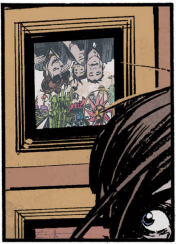
A Ferris wheel, eh?
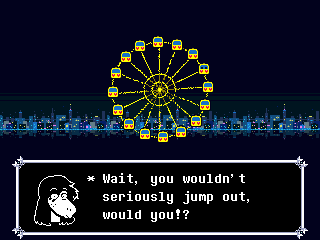
Of course, the Iron Knight imprisoned the darkness years ago while the Roaring Knight wants to unleash it, and Joe leaves the dream world when he opens the fountain while Kris leaves the dream world when they seal it.
Another reason I'm glad I held off on The Invisibles? My head still hurts from The Multiversity.
The Multiversity's entire premise is based on a revelation Morrison had while reading Doom Patrol and tripping out on shrooms (do I have to keep telling you I am not making this shit up?), when they realized they could, like, read the comic out of order. There was this big twist foreshadowed on one page, revealed on another, and Morrison could go back to the foreshadowing with the knowledge of where it was leading, but the characters were just as clueless as they were before. Unfortunately, Supergods does not say which issue of Doom Patrol Morrison had this epiphany in.
At first The Multiversity looks like a retelling of Crisis on Infinite Earths with some cataclysm threatening to destroy all of creation, but while Crisis on Infinite Earths was a combination continuity reset and marketing stunt, The Multiversity is Morrison having a field day with their idea of fiction as alternate realities. Each issue of The Multiversity takes place in a different universe but the comics also appear within the other comics, so each one's events are real in its own issue and a work of fiction in another.
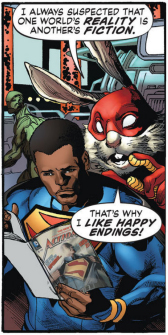
Although in one particularly mindfucky moment, there's an issue where the characters are reading copies of that issue that were brought over from other universes.
But one of the books is said to bear a curse that drives anyone who reads it insane. I don't want to give away too much because it really is one of those things you want to go into knowing as little as possible, especially since the whole point is rereading it with new information and seeing how your perception of events changes. And I know I'll get something horribly, horribly wrong anyway.
"Wait, didn't the Crisis do away with the Multiverse?"
Yeah, but DC brought it back with, I think, the 52 event but limited themselves to 52 worlds instead of infinite.
Even the first reading is kind of nuts. Look at this two-page spread depicting three moments in the same room (I have to link it because in order to get it to a readable size, it was too large for me to embed into the page). I had to stare at this for a while and piece together how the hell I was even supposed to read it. Finally I decided to read everything from left to right, then go back and read just read the daytime scenes, then the dusk scenes of the murder, then the night scenes with The Question investigating the murder. And in the bottom left The Question says "the killer circled clockwise," so maybe I'm supposed to read the panels clockwise?
The truth is you're supposed to jump around in time, re-reading the book different ways.

Okay, I know what you're thinking. "That's totally a ripoff of Doctor Manhattan. In fact, all of Earth-4 is a complete ripoff of Watchmen. The Question is Rorschach, Captain Adam is Doctor Manhattan, Blue Beetle is Nite Owl, Peacemaker is The Comedian, and Nightshade is Silk Spectre." But it's actually the other way around; both The British Invasion and Supergods explain how DC acquired the rights to these characters from Charlton Comics and Alan Moore wanted to, well, basically write Watchmen with them. But DC didn't want Moore smashing up their new toys, so he had to create standins to smash up in their place.
Anyway, it's not just comic books where this can happen, you can do it with anything. Novels, movies, TV shows. Here's a "fun" little anecdote for you. I was sitting in the break room at work one day and M*A*S*H* was playing on the television. It was an early episode when the 4077's CO was Henry Blake, and in this scene he was reminiscing on his dog and his house and his lawn and his kids, and dreaming of the day the war ends and he could go home.
Seeing as how I'm probably the only Deltarune player who knows anything about M*A*S*H* (as if shipping Sans with Blanche Devereaux didn't make me feel old enough), I'm going to drop a spoiler on you: Henry Blake dies. He's released from active duty and replaced by Sherman Potter, but on his way home his plane is shot down by North Koreans, killing everybody on board. So there was Blake, dreaming about walking through his front door and his dog running up to welcome him home while I was essentially an omniscient god, privy to information he wasn't, knowing he was never going to see that dog again.
Which brings us to Undertale and Deltarune. Like Captain Adam up there, both Sans and Flowey are aware of you and your ability to mess with the timeline. The very reason Sans is so indifferent to everything is because he knows at any time, you can get bored and reset the game, putting him back to the outside of the Ruins, so there's no point in him getting excited about leaving the underground. Obviously I don't have screenshots because that's from the Genocide route.
But you really only have two options to muck around with time in Undertale; reload your lone save point, or restart the entire game. Once Deltarune is finished you'll be able to freely jump around the seven chapter starts, but you'll still have to play through them. You can save within the chapters, but you can only have three "bookmarks" at a time and even if you go into the save folder and make backups you can only set them at designated save points. For example, you cannot jump right to the encounter with Spamton in the alley, if you want to see that again you have to get in the car with Queen first, and that's if you even have a save file there. You also cannot jump straight to the end of the game, unless you count hacks.
With a comic you can freely jump around as much as you want. You can jump to any word bubble in any panel on any page of any issue whenever you feel like it. When you see Dr. Sivana with a copy of the "Society of Superheroes" issue you're free to go to that page of that issue and read what he's reading, then come back. I even alluded to this before with Animal Man when I said you could read the rapist getting his brains blown out in issue #3, then jump to issue #19 and read Buddy and Highwater on the flooded mesa talking about it.
You can and indeed are probably intended to read The Multiversity in the order it's published in, anticipating what this "cursed" issue contains, but there's nothing stopping you from going right to the "cursed" issue. But keep in mind that if you do that, you will never be able read the previous issues without that knowledge. Again, I don't want to spoil too much which means I can't say as much about it and Deltarune as I want to, but the "cursed" issue repeatedly taunts you to keep reading, knowing you're going to do it because you - as well as the characters reading it within their issues - don't have the control over it that you all think you do.

Deltarune has a slightly less horrifying way of bossing you around.
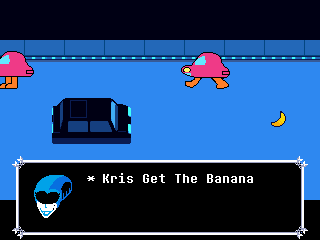
Is it just me is Spamton's yellow eye shaped like Crafty NEO's right (your left) eye in this panel?
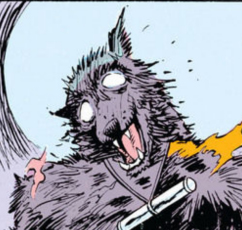
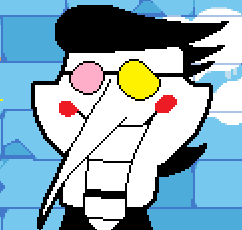
And when Crafty rides the elevator to confront God, is he standing the same way Spamton does, with his feet together and his hands held up at his hips?


When Crafty is standing over the trucker (who, yes, is down on the ground) after both get caught in the bomb blast, the caption block mentions him "reek[ing] of Purgatory, of the Inferno" which reminds me of the flavor text in both Spamton fights mentioning him smelling like rotten glass. Also, I read the break in the clouds as a halo, but saw how the smoke itself could be seen as wings. In The British Invasion, Carpenter went with the smoke as wings.

Carpenter also discusses Crafty's duality. He bears the suffering of his world and dies on a cross, but he was also cast into Hell for challenging God and still seeks to usurp Him. Crafty is both Christ and Lucifer, angel and demon. Like how, depending on what route you take, Spamton can either be a sympathetic victim seeking redemption, or a manipulative devil seeking godhood.
I don't want to spend too much time on fan work, but I have to bring up this Spamton animatic showing Spamton NEO clawing at the sun.


As the Arkham guards are hauling him back to his cell, the Mad Hatter shouts "No room! No room! No roooooom!" This is an allusion to Alice's Adventures in Wonderland when Alice encounters the Mad Hatter, March Hare, and Dormouse and starts to join them at the table, whereupon they shout "No room! No room!" But when they shout it they're saying "There's no space at this table for you." When Tetch shouts it he's saying "My cell doesn't really exist." Like how Jevil denies the existence of his prison.
Tetch also shouts this in Arkham Asylum in response to the Joker announcing Batman's arrival to the other inmates.
After that, the Mad Hatter is not seen for the rest of Animal Man. But when Overman is tunneling Buddy through the floors of Arkham down into the basement they pass his henchmen, Tweedledee and Tweedledum, reading a very relevant passage from Through the Looking Glass.

Admittedly this relates more to Spamton than Jevil, who didn't seem to give a shit that he wasn't real. Spamton fought so hard for his freedom, and his overwhelming joy at the thought of finally becoming "a real boy" made it that much more heartbreaking when his dreams literally come crashing down. Somewhere I saw this fanart of him, crying, pawing for his glasses on the ground, with a caption to the effect of "I don't want to be a puppet anymore."
But this is supposed to be about Jevil and the Mad Hatter, not Spamton and the Mad Hatter's henchmen. Okay, so Batman's voice actor for The Animated Series, Kevin Conroy, cited "Perchance to Dream" as his favorite episode. In "Perchance to Dream" Bruce is trapped in a dream where his parents are alive and he more or less has everything he ever wanted, and somebody else is swinging around Gotham as Batman. He starts to believe this is reality and his adventures as Batman were the dream until something tips him off to the truth. He confronts the fake Batman atop a bell tower, and after a brief fight reveals him to be the one who trapped him in the dream: the Mad Hatter.

Well, technically this is his subconscious manifestation of the Mad Hatter, who asks "Are you the dreamer, or merely part of someone's dream?" He claims this is from Through the Looking Glass, but I read Through the Looking Glass specifically for this and it's not there (both quotes from it in Animal Man are), and searching it on both Google and Bing only bring up this Batman episode. Maybe Tetch wasn't literally quoting Through the Looking Glass but paraphrasing the scene with Tweedledee, Tweedledum, and the Red King.
And how do you beat Jevil mercifully, again? You put him to sleep, trapping him in a dream. But is Jevil the dreamer, or merely part of someone's dream?
A prominent Animal Man character I never talked about - although he shows up in one image I linked to - was the Mirror Master, mainly because any connection he has to Deltarune is pure speculation.

Real name Evan McCulloch, the Mirror Master is primarily a Flash villain, and has the power to... well, basically teleport through mirrors, maybe his powers are explained better in whatever Flash comic he debuted in. He's hired by government agents who are getting sick of Buddy's activism antics to try to intimidate him into backing down, and unfortunately this is right after the Gene Bomb scrambled Buddy's powers so he's all but helpless against the Mirror Master. Thankfully, McCulloch just wants to ruffle Buddy's feathers a bit, then peace out.
But when Buddy doesn't back down, the Mirror Master is instructed to up the ante and whack Buddy's wife and kids. He refuses, and that's when Lennox is called in. We know how that turns out.
With his family dead and no clues to go on, Buddy decides to end it all with a bottle of pills, and in his rage headbutts his bathroom mirror.

As if the smashed mirror was his very own Bat Signal, a certain somebody calls Buddy up willing to help him avenge his family.

McCulloch might just be doing this because he was screwed out of payment, but according to the DC Wiki he accidentally killed his father which drove his mother to suicide which might be the real reason getting Buddy's wife and kids involved pissed him off.
After his dream of Morrison in the rain, Highwater gets weirded out by a mirror in his hotel room.
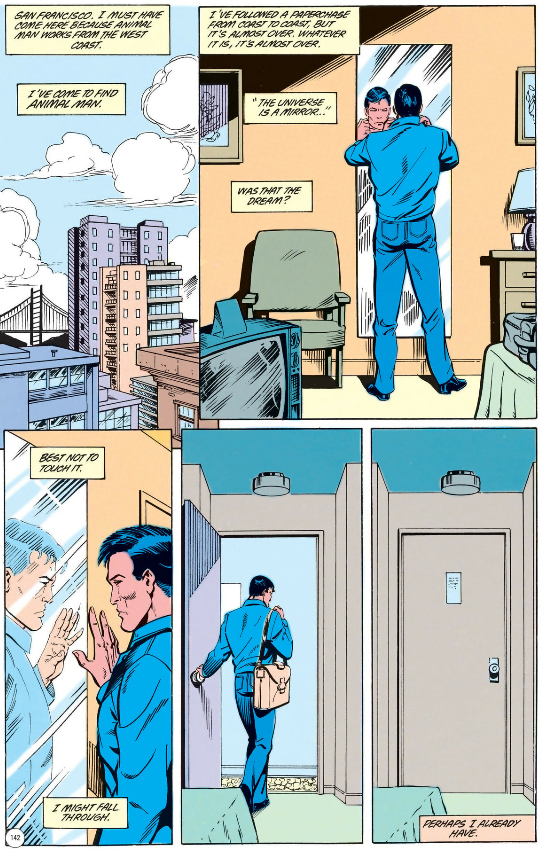
Meanwhile in Flex Mentallo, child Wally used to position himself between two mirrors to create infinite parallel versions of himself (which is also something Morrison did as a kid).

Over in Doom Patrol, one of the members of Mr. Nobody's second Brotherhood of Dada is a sentient pile of mirror shards. Which, by the way, was created when its owner threw battery acid at it.

In Arkham Asylum, Batman has a flashback of his father berating him for freaking out over Bambi's mother getting shot, whereupon he punches a mirror and stabs his hand with one of the shards.

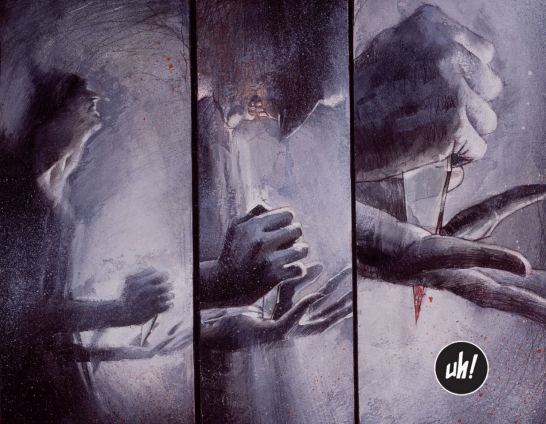
And when Joe is shown a mural in the pirate city depicting the fabled "dying boy," in reality he's looking at himself in the bathroom mirror.


Aside from a reference to two universes that mirror each other and maybe this shot of Captain Adam with some sleazy politician being reflected in a river, mirrors don't play much of a part in The Multiversity. But the 52 series, which Morrison collaborated on, opens with shots of the characters in floating mirror shards.

In the Light World, the Shadow Crystals are shards of glass. I wonder, could they be pieces of a broken mirror? In Through the Looking Glass Alice saw the fantasy world through a mirror before falling through it, and in Deltarune you see the Light World through the Shadow Crystals.
And yes, I hypothesize that a future secret boss will be fought in a house of mirrors.
We already talked about the computer's text cursor as a door Morrison uses to connect our world to the comic, and Buddy passing through doors to get to the City of Formation and Morrison. But when Highwater arrives at Arkham Asylum with Trano and Zaarn one of them tells him "the doors lie open." Yes, they're literally entering the doors of Arkham, but it also refers to how the doors to the infinite worlds lost in the Crisis have been opened by the Psycho-Pirate.

Which isn't the only time a Morrison books depicts the doors of Arkham as the gateway to madness.
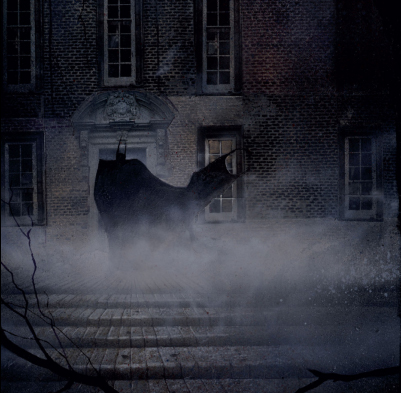
When Highwater gets the alternate characters to accept their fate as memories, they disperse into colors and enter the Psycho-Pirate's mask, turning it into a gateway to the lost worlds. But if not kept in check that door will soon break open again, which means Highwater has to put the mask on and resign himself to a corner of Arkham to hold it shut.

So yeah, Highwater is basically Bolvar Fordragon at the end of Wrath of the Lich King, donning a cursed piece of headware to stand sentinel as the only thing keeping the world of the living from being ripped apart by the dead.
Flex Mentallo opens with a member of Faculty X - which yes, we've discussed is the Fact but let's pretend we're as clueless as Flex here - leaving a bomb in a crowded airport. Flex moves to intercept it but before he can do anything it fizzles out, revealing it to be a gag bomb. Flex calls the bomb the key to "the strangest door of all" (which yes, looks like "the greatest deal of all" but I'm trying to keep the apophenia to a minimum, here) as the comic shifts up a reality to Wally in his apartment. When another member of Faculty X disappears into a photo booth and leaves behind a photo strip of the Fact, Flex mentions that door again.
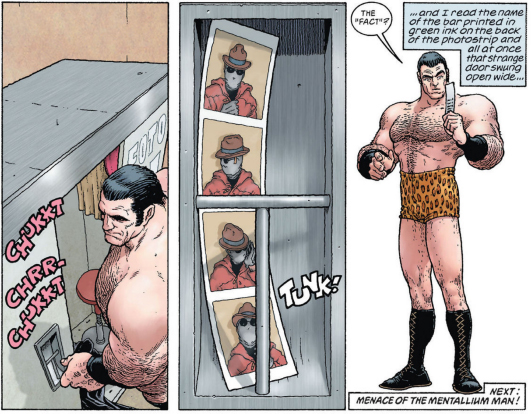
Wally recalls a moment during primary school where he and Flex saw each other through a door. Although in any other context, a half-naked man watching a little boy would be kinda fucked up.

When Dorothy is making her deal with the Candlemaker to kill the Telephone Avatar, it tells her to "open the door for [it]" and let death in.

And when Cliff interfaces with the Think Tank, to get to the actual core programming of the nanomachines he has to pass through a door guarded by, uh, Caulder's severed head on a welcome mat, wearing a potted plant? Did I ever mention this comic is absolutely bananas?

When Joe comes home from a bad day of school he absentmindedly leaves the front door open, which allows something to get into the house, and by extension the dream world, later on.

Later on Joe and his dream friends, Zyxy and Smoot (who are based on kids from Joe's school although Smoot appears to be based on a bully?), try to get help from the queen to battle King Death. She locks him up instead, intending to keep him safe, and in reality he's huddled by the fireplace. Zyxy and Smoot break him out, but when they walk through the door to his room they briefly enter Joe's reality.
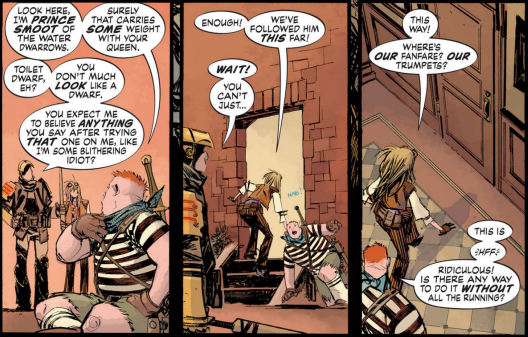
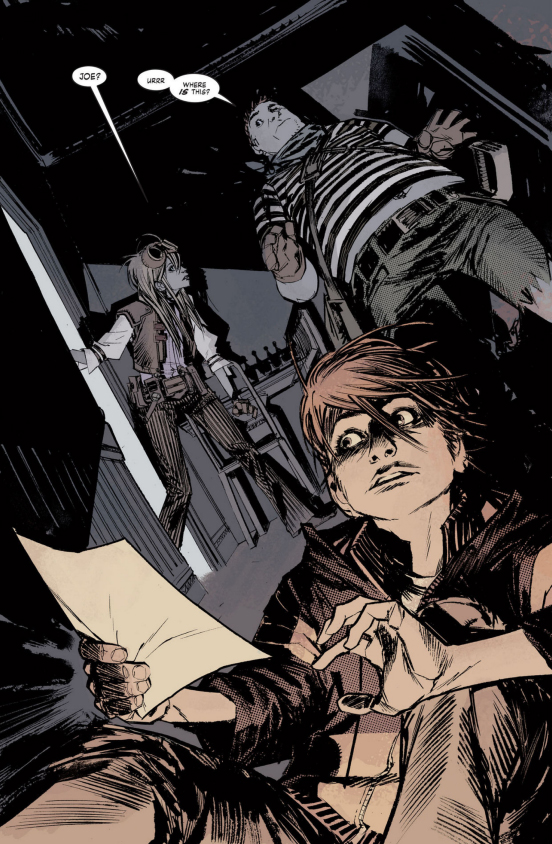
Joe wasn't hallucinating them, Smoot calls it out.
To compensate for the lack of mirrors, The Multiversity has about a hundred references to doors so let's discuss the meaning behind them all. For the sake of spoilers and to cover my own dumb ass when I inevitably misunderstand something, let's say the antagonists of The Multiversity are these demons that inhabit one of the 52 worlds called the Gentry. Their plan is to manipulate Nix Uotan - again, we'll just say he's a god-like being tasked to defend the Multiverse - into opening the doors between the universes to allow the Gentry to invade the other worlds. This ends up being the key to defeating the Gentry because doors go both ways, and the characters gathered to protect the Multiverse can now take the fight to the Gentry.

Also, it took me an embarrassingly long time to realize Nix Uotan having a chimp for a partner is a reference to the Infinite Monkey Theorem.
What are the Dark Worlds always behind? Doors.



What do you use to teleport around Dark Worlds? Doors.
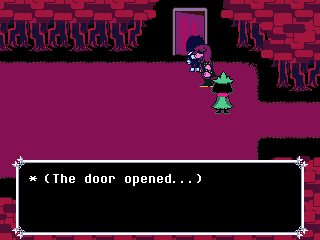

What does the ending of Chapter 2 make a point of showing us Kris doing? Opening a door.

And I don't think it's a stretch to think of the game window as a doorway between our reality and Deltarune. And doors go both ways.

During the Thanagarians' invasion of Earth, one of them, Rokara Soh, conducts a Thanagarian ritual in which he drinks a poisonous cocktail and unveils his greatest artistic masterpiece to all. His is to plant a bomb with the intent of detonating a fault line and destroying California, but before that it puts on a show, telegraphing his memories around the world. One of them depicts his father showing him the fractal nature of creation while he stares in both awe and disappointment that he will never be able to see everything. In the current time, he accepts he can only see so much as the poison kills him.
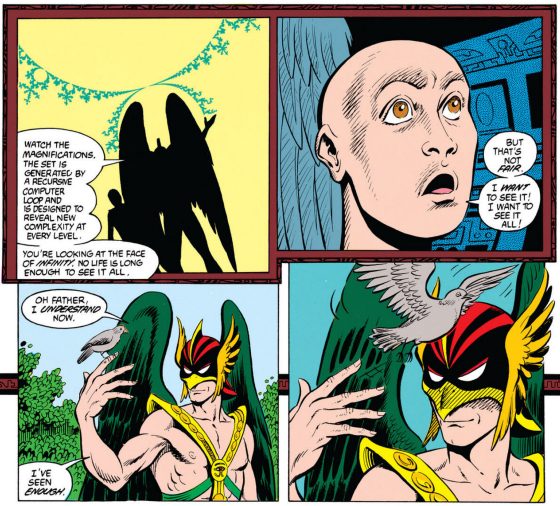
When you're a kid, you want to see every movie, read every book, play every game. You want to visit every world. You want to see it all. But in the time it takes you to visit one world, another lifetime more have popped into existence. There finally gets to be a point when you're an adult, and you say to yourself "I've seen enough." Think about how many untouched worlds exist in your Steam library.
Another of his works was a giant bird made of fractals, simultaneously a part of creation but also containing all creation. As Highwater explains on the mesa, we're all part of the great fractal, each of us connected and affecting one another.

There are many different ways worlds split off into more worlds. The universe gives rise to countless galaxies which give rise to countless worlds, each with the possibility of intelligent life. Our world gives rise to billions of humans, and each of us could produce a theoretically infinite number of worlds, though we only live long enough to let a fraction of them out.
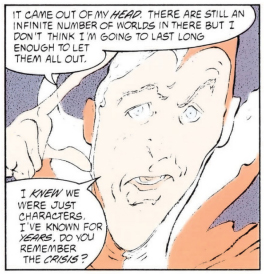
And each of those worlds can inspire countless others. The Scarlet Pimpernel inspired Zorro, Zorro inspired Batman, and God knows how many characters Batman has inspired. In Supergods Morrison explains how their own idea of fiction as alternate realities was inspired by Flash of Two Worlds and another Flash story in which a mad scientist creates a laser that erases everyone's memories of the target (let's not question how you would test such a device, since you'd no longer remember the test subject) and uses it on his cat, and with nobody to remember her she vanishes from existence. At least in-universe because we, the reader, will always remember that cat.
This also illustrates why the Crisis was ultimately futile. It was supposed to streamline the DC Universe and trim the fat, but it couldn't erase the higher reality's memories of what was before the Crisis. Future writers kept bringing back the stuff they liked that didn't make the initial cut, often making up new backstories for it (i.e. changing Bizarro from an alien from a cube-shaped planet to a clone of Superman) and DC ultimately brought the Multiverse back. It was like zooming into a particular area of the fractal; it just splintered off into infinity again.
While Deltarune is usually talked about in three paths (pacifist, no mercy, and Snowgrave), there are theoretically infinite paths you can take that only get more spread out as more chapters release. They could be as utterly inconsequential as going in a slightly different direction, be an actual choice that may or may not amount to anything like who you give the carnival prize to, or have long-lasting effects like how you design the tank in Chapter 1. There are choices that are only available if you take another choice, like how you can only fight Spamton NEO if you take his deal in the alley (if you beat him up, he won't open his shop and you'll be locked out of the fight). Individually, we will never be able to see every path Deltarune offers, but collectively we can find as many as possible and share information with each other. All these choices may not amount to anything if the ending is Fox saying "Fuck you and your choices, here's what I decree happens," effectively collapsing the fractal into a black hole, but it's the journey that counts.
And that's before we get into the ungodly amount of fanfic it's inspired.
I was going to talk about this before, but figured everyone was getting tired of my sidetracks into Berserk when I was supposed to be talking about Deltarune and Animal Man and cut it. So let's talk about it now.
The world of Berserk is divided into three overlapping worlds, the Physical World, the Astral World, and the World of Ideas. The Astral World is where the souls of the dead and creatures of human imagination reside, and is frequently compared to water. The Godhand and the Skull Knight are always banging on about the flow of causality. After his branding Guts resides in an area between the Physical and Astral worlds, and the Skull Knight compares him to a fish that can breach the barrier between the worlds and creates ripples in causality. The deepest layer of the Astral World, the Abyss, is a whirlpool of tortured souls. The Skull Knight's Sword of Actuation which he uses to create rifts into the Astral World is called the Sword of Pump-Priming in Japanese, referring to how it taps into water and draws it to the surface.
I have not been able to relocate where I saw this so take it with a fistful of salt, but somewhere I read the Great Roar of the Astral World was called the Great Wave of the Astral World in Japanese. Except according to the Berserk Wiki the kanji for the Great Roar's Japanese name translates to "Great Ghost World Roar/Howl." And there's debate over whether the Idea of Evil is canon, but it calls the Behelits, which Apostles use to temporarily bring the Astral World up to the Physical World "droplets" sent to the Physical World from the depths of the Astral World. Personally I think the Idea of Evil is canon, and Miura removing the chapter from collections wasn't him to try to retcon it, but him trying to put the genie back in the bottle after deciding he'd revealed it way too soon.
Now, it's virtually impossible for either Morrison or Miura to have gotten the idea from the other. Both Animal Man and Berserk debuted in 1988, Berserk didn't get published in English until 2003, and I can't find any evidence that Animal Man has ever been officially translated into Japanese. I can't rule out the tiniest of chances of a fan translation in some obscure corners of the Japanese web, but that'd be well after Berserk debuted anyway. And it's perfectly possible for Morrison and Miura to come up with the idea separately: water is the source of life both in that individual living organisms need it to survive, and life itself started in the primordial sea. Water is also a substance with no form on its own, but when acted on by something else can assume any shape.
I'm pretty sure both drew from the Dreamtime. Warcraft has the Emerald Dream, a dream world connected with nature that Druids are especially sensitive to, and enter by sleeping. And the Bone Coda talks about the Dreamtime, which the Dreaming was based on. Interestingly, the Dreaming is also the name of Dream's realm in Gaiman's Sandman but that's a can of worms I'm not opening yet.

Yes, I too am having a nerd rage over that passage failing to mention Mim is clearly an Ouroboros.
And you know how a ring covered in thorns is a key component of a Snowgrave run? The Skull Knight's sword is covered in thorns.

Now that I think about it, that Homestuck character (I think her name was Rose?) sacrificing her pet for power sounds an awful lot like an Apostle. Maybe Fox having read Berserk isn't as unlikely as I thought.
And now for various bits and scraps I have lying around, in no particular order.
The reason Animal Man changes so drastically with "The Coyote Gospel" is because Morrison's Animal Man was originally only supposed to be a four issue miniseries. But it did so well DC asked Morrison to continue the series, and that's when Morrison got the idea to use the book to explore metanarrative, starting with "The Coyote Gospel." Carpenter cites "The Coyote Gospel" not necessarily as the best or most famous thing Morrison ever wrote, but the most important thing Morrison ever wrote.
Spamton keeps calling Kris "little sponge." Sponges absorb water which we've established from Animal Man, Doom Patrol, and Berserk is a metaphor for imagination and potential. And it's strange that I keep calling back to Final Fantasy X here because that's another instance of dreams being connected to water.
I wonder if Deltarune was also inspired by The Phantom Tollbooth. If Fox has read Wayside School he has to have read The Phantom Tollbooth, that was pretty much required reading in 90s elementary schools. It's about a boy named Milo who doesn't care about anything going on around him until a mysterious ride-on train arrives in his house, and riding it takes him to a fantasy world full of wacky characters based on abstract concepts and puns like the princesses Rhyme and Reason, a watchdog who's literally half watch and half dog, and the Senses Taker. He even spends the next school day excited to ride it again, like how Susie wants to go back to the Dark World as soon as possible at the start of Chapter 2.
"The British Invasion" originally referred to a period in the 60s when British bands like the Beatles and the Who became popular in America, and was then given to a period in the late 80s when American comic books, mainly DC, brought in writers and artists from across the pond who turned the idea of what comics could be on its head. Alan Moore, Grant Morrison, and Neil Gaiman are considered the Holy Trinity of it, but it also included Brian Bolland, Dave Gibbons, Warren Ellis, Peter Milligan, Jamie Delano, and many others. It's something of a misnomer because Morrison is Scottish, Milligan is Irish, and don't quote me on this but I believe Garth Ennis was part of it and he's also Irish. But I guess "The UK Invasion" doesn't sound as catchy and heck, Frank Miller is often lumped into it and he's American.
Animal Man makes a small appearance in Crisis on Infinite Earths, where he does little more than make dumbass quips like DC was trying to turn him into their Spider-Man.
When Highwater finds the book in his apartment he calls it "Through the Looking Glass" but the book itself says "Alice in Wonderland." But Alice's Adventures in Wonderland and Through the Looking Glass are usually combined into one volume, so I think we can excuse this.
The first volume of the three-volume Animal Man trade calls each issue a "chapter," going up to Chapter 9. For whatever reason, this does not persist through volumes 2 and 3.
There are actually two types of Men From N.O.W.H.E.R.E. The cartoony ones that fought Danny the Street are knockoffs Darren created based on schematics he stole during his time at the Pentagon. The real ones under the Pentagon aren't as much fun.

In Supergods Morrison calls Animal Man's penciler Chaz Truog, with a Z. I don't know why the credits in the comic call him Chas, and it's not the font because you can see what a Z looks like on Doug Hazlewood and John Costanza. Either both are viable nicknames for whatever his full name is, or his own handwriting made his Zs look like Ss and somebody misread it.
Remember how I commented on Animal Man's outfit resembling Booster Gold's? Not in the sense that you couldn't tell them apart if they were standing next to each other, but in the sense that if you had no idea who Animal Man was and saw him, you'd think somebody drew Booster Gold hilariously off-model? Well, I wonder if Morrison thought the same thing because after Mr. Nobody sucks Paris into the painting, three heroes are standing by it, scratching their heads when the Doom Patrol arrive. One is Blue Beetle, and the other two are...
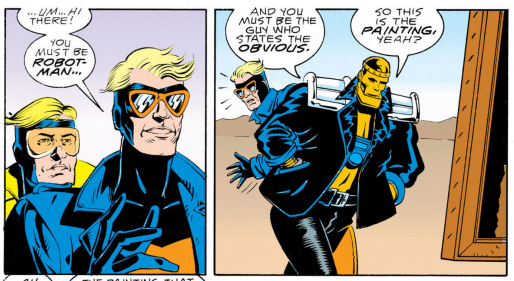
Fun fact, Booster Gold was the first mainline DC hero created after the Crisis.
When the Red Mask is telling Buddy his backstory, he mentions him and the Veil having a fight with a superhero called Captain Triumph.
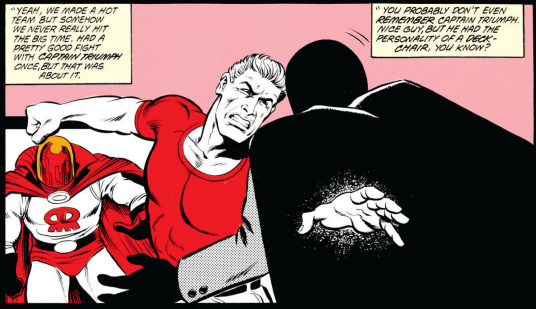
Captain Triumph did actually exist prior to Animal Man; he was a World War II-era hero from Quality Comics, a publisher DC bought out in the 50s and turned into Earth-X where the Axis Powers won World War II and America fought an endless war against Mecha Hitler until the Crisis reset everything. But the Red Mask and the Veil were created in Animal Man, so Morrison is rewriting history here because nobody was going to go back and check, and it's post-Crisis anyway so anything is fair game. But if you were going to base your boss on a character fought with the help of a raggedy, shadowy cape-like object, which one would you go with:
1) Some doofus in a t-shirt the book itself admits nobody has ever given a shit about.
2) Evil Superman With a Nuke.
When Buddy goes into Comic Book Limbo he runs into a group of kids offering him money if he can get them out.
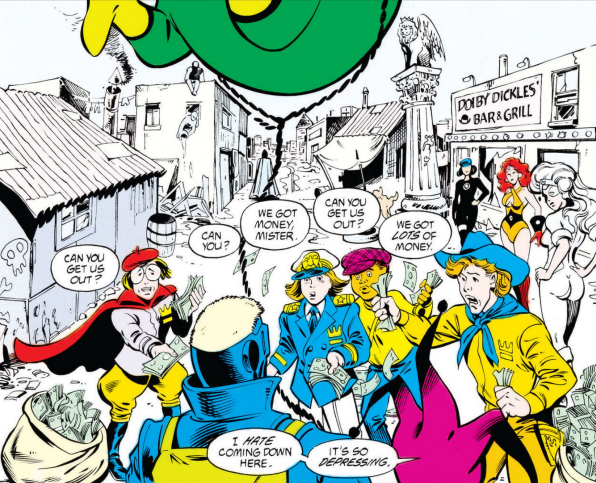
My first thought was "Who the fuck are these kids, and if their books were so successful and made so much money, what are they doing in here?" A little digging revealed those kids are known as the Green Team and their gimmick was they were bumbling dipshits with more money than sense, and their solution to every problem was to throw cash at it. Yeah, can't imagine why nobody's brought them back.
When Merryman tells Buddy to take the dying monkey to the City of Formation, he says the City of Formation lies beyond the ruined cities of Atlas and Warren. Both are technically defunct comic publishers, but Atlas was revived as Marvel a couple years after it went belly-up.
Honestly, all the references to old comic books in Animal Man remind me of all the references to old video games like Mega Man OG and X, Punch-Out!!, Kirby's Adventure, and Final Fantasy in Deltarune Chapter 2.
"Wait, Kirby's Adventure and Final Fantasy?"
Yeah, everyone compares Spamton NEO's face attack to Ranga Bangda, the face-wall boss from Mega Man X, and I guess they get that from his eyes, nose, and mouth being his weak points and samples of the Vile boss theme being mixed into "BIG SHOT." But it always reminded me more of Whispy Woods from the Kirby games, especially the way he blows puffs of air at you. As for Final Fantasy, the Spamton angels are clearly based on the revive angels, and I'm pretty sure Giga Queen's boss theme "Knock You Down !!" is supposed to be a joint reference to Punch-Out!! and "I, Garland, will knock you all down!!"
When Mr. Nobody marries Bobby and Doctor Silence's cloak, the panel turns into a heart. Read enough comics and you'll find plenty of examples of panels shaped like something other than squares, rectangles, trapezoids, and other four-sided polygons. Going back to that idea of the battle board as a comic panel, some enemies turn the board into something else such as Queen occasionally turning it into a wine glass ... okay, I'm pretty sure Mr. Nobody and Queen both throwing their arms up while doing this is a coincidence, but at this point... I don't know what's going on.
In Supergods Morrison talks about how the moon symbolizes the fantastic while the earth symbolizes the mundane. In Flex Mentallo, Flex is being lit up by the moon in the panel where he's talking about looking for the Fact, and at the end he ends up on the moon where the engine to create worlds lies. Arkham Asylum ends with Two-Face scattering a tarot deck and the camera focusing on the moon card. When Susie breaks into Noelle's room to rescue her, Noelle is watching the moon.
I'm not sure if this is something DC went through with or was an idea that got scrapped but according to Supergods the first edition of Arkham Asylum was deliberately bound in such a way that the book would start falling apart soon as you started reading it, playing into the story taking place on April Fool's. Why does that sound like something Fox would do if he were ever asked to make a comic? I also wonder how many people got the joke and how many thought it was just shitty manufacturing?
Flex is given the order form for the package that turns him into a superhero from a guy who has television on his forehead, with a monochrome picture of Charles Atlas on the screen.
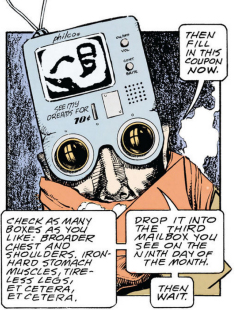
Which is reminiscent of that television Omega Flowey has on his forehead, with the monochrome screaming face in it.

During their little heart-to-heart chat, Grant and Buddy stop by a river so Grant can throw a rock into it.

One of the preview images released in the September 2022 update shows Susie throwing a rock into a lake.

Remember how I said Grant Morrison believes they're a wizard? Morrison is specifically a chaos magician (that page appears to be ten years out of date because Morrison has been with DC for well over twenty-five years by now, but reminder that Morrison has stated he's fine with all pronouns, and she doesn't actually care what anybody refers to them by).
The King, Queen, and Knight are all chess pieces. Joe the Barbarian makes a point of showing us Joe staring at a chessboard his mother's dream equivalent keeps in her room.

Early into writing the main essay, where I wrote "A light-hearted version with the dolphin slaughter replaced with a bake sale" I had written "the dolphin slaughter replaced with bananas" because I was trying to think of the silliest thing in the game to contrast Animal Man's dolphin massacre. But because I was using Queen telling us to get the bananas as an example of how we're not as in control of Deltarune as we think we are, I figured I'd change it to something else and went with the bake sale. Later on, when I replayed Deltarune for screenshots, what did I see on the first sign outside of the trash zone?

A dolphin and a bunch of bananas. I swear I'm not lying about this.
Why does Heat Miser look like Lennox?

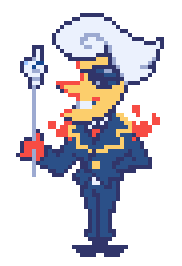
Given the big smile that appears on the television at the end of Chapter 2 and if he actually was inspired by a goddamned assassin, I'm starting to wonder if that's Mike and he and his partner are supposed to be either the Bishops or the Rooks. But I don't think Fox would spoil something as big as the main villain, so I'm inclined to believe Thunder and Storm are more on the level of Swatch and Tasque Manager, high-level assistants to the big bad.
(Okay, so the Valentine's Day newsletter reveals that character's name is Lanino and his partner is Elnina, after the El Niño and La Niña weather patterns. So yeah, he's not Mike. Stiiiill want to know why he looks like Lennox.)
Because I was reading on my Kindle and couldn't see the fine details, when I first saw this passage of Lennox learning about everyone involved in the assassination of Buddy's family getting picked off, then getting ready to inject himself with something I thought "Oh, he's just shooting himself up with heroin to deal with the stress" and moved on.

Turns out, that's a bottle of insulin and Lennox is diabetic. Maybe it's just because I made this discovery shortly after finding out my cat was diabetic, but that bottle freaked me out and brought up so many questions. What is Morrison trying to say by giving Lennox that detail? Are we supposed to laugh at him for it, or feel the tiniest pang of pity for the killer? Is it implying Lennox went into assassination to pay for his medicine? Or for the sense of power because being diabetic made him feel emasculated? Is Lennox diabetic or is he using insulin to steel his nerves for the job? Is that something you can even do with insulin? Is the finger wand supposed to be a diabetes thing??
And Joe the Barbarian is about a diabetic kid, so was somebody close to Morrison diabetic?
M in the phonetic/military alphabet is "Mike." And F is "Foxtrot." If Q was Queen and K was King I'd put more weight on this, but for now it's just an amusing aside.
During the car ride, Queen says she's concerned about Noelle clipping into a wall.
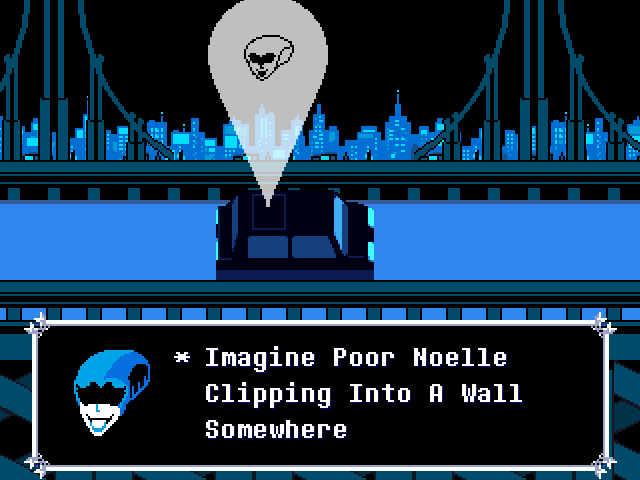
Yeah, it's obviously a gaming/coding joke. But when Highwater and one of the aliens (the other went to go find Animal Man) are walking through Arkham they pass a character the Psycho-Pirate accidentally spawned inside a wall.

Also, I think it goes without saying that Queen's signal is itself a blatant reference to the Bat Signal.
What the Telephone Avatar says to Dorothy and Flex during it battle is awfully similar to what the Veil shouts to Overman before he and Buddy yank him out into the white space of the comic:
The Veil: "The things. The things I've seen. The things I see. Look! Look!"
Telephone Avatar: "Listen. This is what I hear. Listen. Listen."
One of if not Cliff's biggest struggle with his robot state is that while he can see and hear, he cannot taste, smell, and most of all feel.

Sure, we're talking physical feeling here, Cliff is still capable of human emotions. But in Undertale, what eventually drove Flowey insane was his inability to feel emotions.
Also, I just realized the word "FOXY" is graffiti'd on the wall in that last panel, no doubt a reference to Morrison's imaginary friend, Foxy.
Another reoccurring theme in Morrison's work is the futility of violence. Crafty got fed up with his world's endless cycle of violence that never went anywhere. When Buddy kills Lennox he still feels empty inside. Morrison wrote a three-parter for Spawn when Todd MacFarlane was bringing in famous writers after realizing he couldn't write worth a damn (and oh boy, if you're in need of a headache for some reason check out the Todd MacFarlane/Neil Gaiman shitshow) in which Simmons battles one of the men behind his murder who's been empowered by angels. At the end he encounters his old boss, shoots him in the head, and realizes the act brought him no joy.
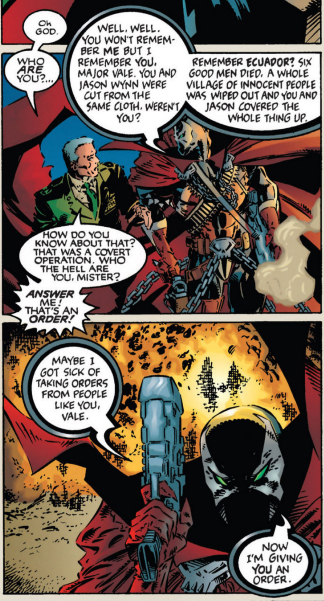

There's a mildly amusing story behind this. MacFarlane originally brought in Alan Moore, Neil Gaiman, and two or three other big-name writers, but not Morrison. Some magazine, probably Wizard, did an article on Spawn's guest writers and, figuring all three of the British Invasion's holy trinity were involved, included Morrison. Morrison saw it and thought "Well that's the first I've heard of being involved with Spawn" and got in touch with MacFarlane, who pretty much said "Sure, why not."
This even pops up in the Doom Patrol show. Towards the end of the the third episode Cliff is in a cellar hallway, surrounded by assassins dressed like they're going to the weed cave, gearing up to kick his ass (if this scene is from the comic, it's not the Morrison run).

And he rips them apart.
I mean that literally, Cliff tears one of them in half and bludgeons another one with his legs. And the whole time, you're in the same "I'm not trapped in here with you, you're trapped in here with ME!" rush he is. But when he's finished them off, he looks down at mess he's made, the adrenaline wears off, and both you and Cliff are left with the feeling of "...oh dear God..."
Which brings me to a question I have about Undertale and Deltarune: what do people get out of doing a Genocide or Snowgrave run? Bragging rights that they've beaten Sans and Snowgrave Spamton NEO? Whoopty-fucking-doo.
On the other hand, pacifism in Deltarune is also ultimately futile. You can go all of Chapters 1 and 2 taking the Mercy option but in the end, you have no choice but to slug it out with King and Giga Queen.
And on the note of "making somebody who can't disobey you do horrific things for shits and giggles" there's a bit in We3 where the scientists that turned the three pets into weapons are showing off their project to use rats to build military hardware, including one whose head has been either replaced or covered with a drill. The scientists control them with what's obviously a video game joypad.
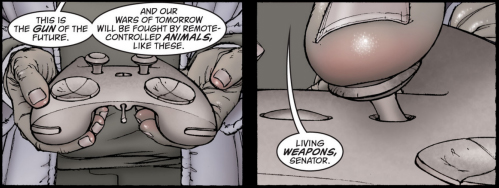
One of the scientists takes the controller and makes the drill-headed rat eviscerate another one, just because he thought it'd be funny.
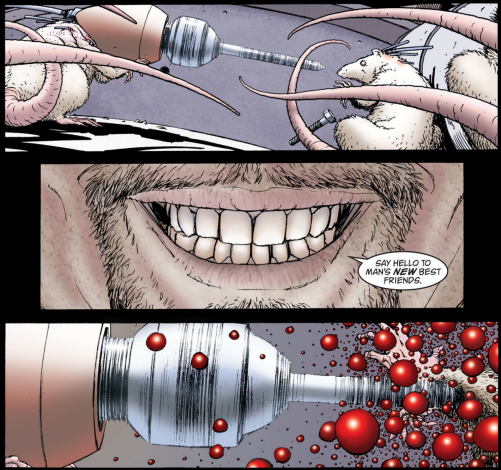
And you know what else keeps popping up in Morrison's books? Knights. I mentioned the Knight Club in Flex Mentallo, the Dark Knight in Arkham Asylum, and the Iron Knight in Joe the Barbarian. But when future Buddy is trying to warn his family about Lennox, Ellen is painting a cartoon of a knight.

And when Jane is in the Candlemaker's Hell, she tries to cope by slipping into a dream where Cliff and Rebis rescue her while dressed up as knights, until some electroshock therapy completely breaks her.
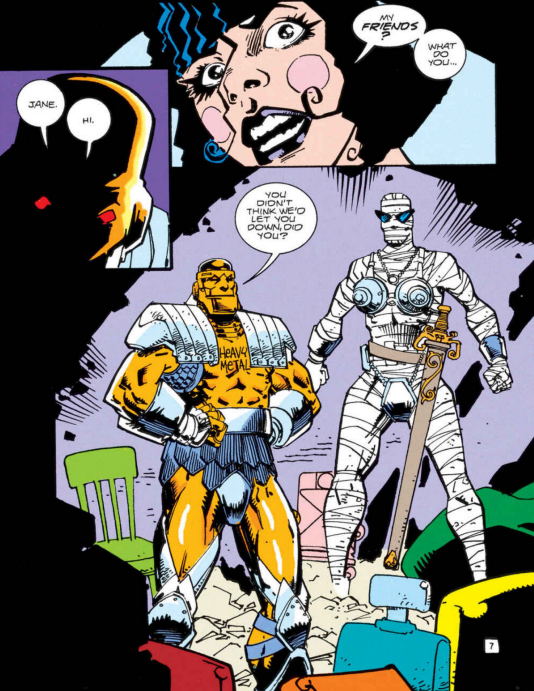
Yeah, okay, they look more like strippers roleplaying as knights, but still.
A glaring omission you may have noticed through all of this is All-Star Superman. That's because All-Star Superman isn't about alternate realities and metafiction, it's basically Morrison sorting through their thoughts of mortality after the death of their father. Morrison does use it to explore the idea of humans becoming gods, though.

Now, Jor-el doesn't mean we will literally float up through space and into the sun, it's metaphor for ascending to godhood. The same way somebody else associated the sun with BECOMING [God].
The Candlemaker keeps jabbering on about how nothing is real and that means it can do anything.

This could be read as the Candlemaker being self-aware that it's a character in a comic, but I think it's talking about being death incarnate and death being realer than anything else, a theme that pops up in Discworld a lot. Although you can't help but think about somebody who was aware of the world around him not being real and kept saying "I can do anything!"
Side note, I'm impressed Cliff can even drive that car without it collapsing considering he probably weighs twice as much as it does.
Morrison brings Overman back in The Multiversity but reimagines him as Superman if raised by Hitler, which isn't quite as much fun to goof on as Evil Superman With a Nuke. One tidbit was kept intact. Animal Man stated that in his world, all the other superheroes were created from Overman's cells, which is a metaphor for Superman being the basis for the modern superhero. In The Mutiversity, Overgirl of was cloned from his cells.
While not written by Morrison, Crisis on Infinite Earths has a few of its own weird parallels with Undertale and Deltarune. The Anti-Monitor has this army of shadow men who instantly kill anybody they touch, and at one point all the little shadow demons merge into titans of darkness.

Towards the end of the book, the Anti-Monitor sends a swarm of them to blot out the sun, plunging the entire Earth into darkness, the same way the Roaring will engulf the Light World in darkness.
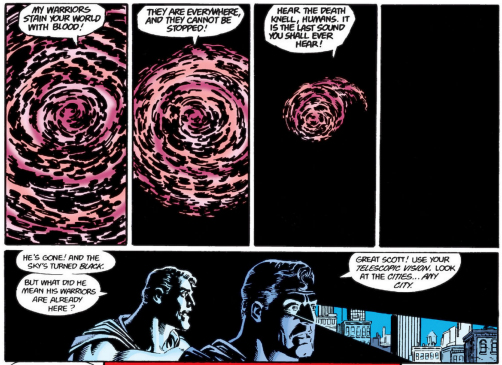
And after the big universe reset, Earth-1 Superman, Earth-2 Superman, Jay Garrick, and Kid Flash try to use the Cosmic Treadmill to visit Earth-2, but all they find is "an endless expanse of black."
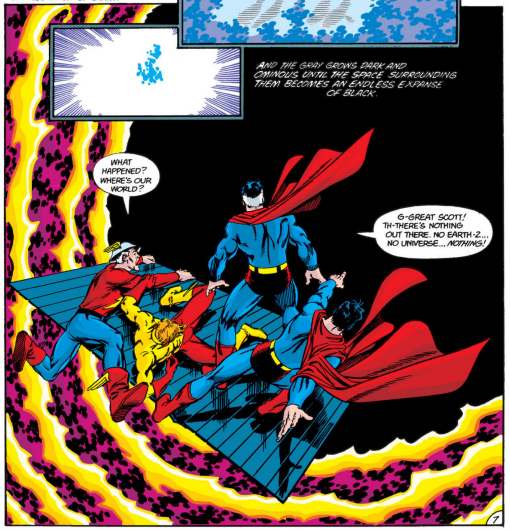
Which looks a hell of a lot like the void you find if you try to return to Undertale after destroying it at the end of a Genocide run.
I could only stomach a few issues of the Peter Milligan run on Animal Man (so you retcon the entire Morrison run as a dream Buddy had while in a coma to make me read about Buddy pissing on his own lawn? Fuck that), but of what I did read, a couple things stood out:
1) Buddy's wife has an affair with a guy named Mike.

2) Buddy teams up with Nowhere Man, a glitch man whose words are frequently replaced with gibberish.
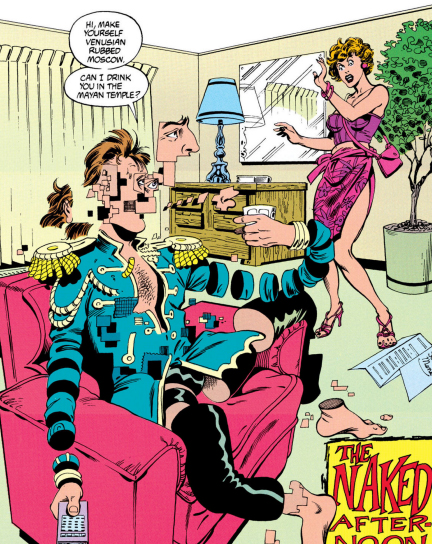
When the fight breaks out between Overman and the other revived characters in Arkham, the Psycho-Pirate tries to stop it by pointing his finger at the readers and calling us "the real enemy."

Now, at this point I'm about 99% certain Fox was inspired by Morrison's work but unless Fox himself says so or Chapter 3's secret boss is obviously based on either the Red Mask or Overman, I can't be 100% certain. It's not totally impossible for Fox to have come up with all of this independently of Morrison, although I'd like to sit down with him and hear him explain what the hell is going on with Spamton and the Telephone Avatar, Jevil and the Mad Hatter, and the entirety of Joe the Barbarian if that's the case. But it doesn't matter; if the whole point of Deltarune really is that the player is the true villain, regardless of whether they play pacifist or Snowgrave, and we're supposed to pretend Gaster is its creator and Fox has nothing to do with what his own characters are going through, then he is still going to be devoting a significant portion of his life and tearing up his wrist just to create a thematically obsolete version of a comic that, at this rate, is going to be almost fifty years old by the time Deltarune is finished.
My understanding is Fox intends for the Knight to be the game's final boss. This is why, if Fox really is the game's true villain rather than... you know, the player... I'm more inclined to believe he's a separate entity pulling the Knight's strings rather than the Knight itself because how would a boss fight against Fox work? I guess the final battle could be against a fake Knight that when defeated, fades away so Fox can have his big Morrison reveal.
And if Fox is controlling the Knight, that still leaves the mystery of who the Knight itself is.
While I still haven't been able to find anyone else discussing Deltarune with Animal Man, some digging uncovered a podcast discussing Homestuck and Animal Man. I haven't listened to it because you have to pay for it on the creator's Patreon and it seems to be focused more on Homestuck and as I made clear earlier, Homestuck lore is basically another language to me.
I held off on The Invisibles but both Supergods and The British Invasion talk about it. The main character, King Mob, is another self-insert/fiction suit of Grant Morrison and adopts multiple personas to, I think, protect himself from the aliens that secretly control the world? One of them is a comic writer who writes about a character called Gideon Stargrave, also a character Morrison themself wrote when younger, and I don't think I need to tell you what "Stargrave" looks a hell of a lot like. And Morrison's Zenith features a character named Ruby Fox. What the hell is going on?
Another weird mistake Carpenter makes in The British Invasion is he calls Youngblood Rob Liefeld's most popular character. But Youngblood wasn't a single character, it was a team like the X-Men or the Doom Patrol.
A bit of trivia I picked up from The British Invasion was that Alan Moore's first job was a livestock processor, and he and his coworkers would blow off steam by throwing sheep testicles at each other. That has absolutely nothing to do with Grant Morrison or Deltarune, I just wanted to share it with you.
When I took the time to Photoshop comic Morrison's hair onto real Morrison, maybe I could have just done a search for "young Grant Morrison":


Massive tinfoil hat apophenia moment here, but I got a chuckle out of it. "Deltarune" is almost an anagram of "Dreamtime" just with LUN instead of MIM. And "Mim" is the name of the dragon queen and guardian of the Dreaming from Bone I mentioned earlier.
That said, the letters LUN appear in "Nagual," another name Highwater gave for the higher reality. But I'm not going to treat this as some smoking gun until a future chapter of Deltarune features a macguffin with the letters AGAMIM.
Here's a quote from Supergods, towards the end of the "Superpop" chapter as Morrison describes the fallout of their parents' divorce following their father's affair:
Entering adolescence, as if overdosed on the illusory, I began to find myself slipping into a disassociated state in which the world seemed flat and unreal; as if I were seeing through to a cardboard world lacking in significance, painted on screens I could no longer touch. Even comics seemed dead to me, stripped of their magic and emptied of color. I was acutely aware of the exact moment when my toys ceased to be alive and when the play environment lost its potential to be anything I wanted it to be and only became a room.
That last sentence sounds familiar.

And here I'm going to acknowledge and correct myself on a few mistakes I made and one... I wouldn't call it an error, but there's something I need to to say about it.
Two things I did go back and edit. First, I kept calling Morrison's cat "Jamara" but when I read We3 which Morrison dedicated to a bunch of their old pets I saw her name was "Jarmara." I guess the font in Animal Man is a little jumbled? Second, I asked about Kris having a scarf with horns when they were a child, but didn't have screenshots of it. Since I had to revisit the ending of Chapter 1 for some screenshots I remembered to talk to Toriel about it and it wasn't a scarf, it was a headband. The others, yeah, I could go back and edit the previous essays for as well, but they're more than one-letter misreadings or something I never actually stated as fact and only asked about and could fix when adding the screens, and that feels like brushing my mistakes under the rug when I'd rather own up to and explain them where necessary, especially since one of the things I got wrong feels more like a mistake on the part of DC's editors.
I made three minor mistakes in the original "The Knight needs to be Fox" essay that don't affect the big picture, but I still need to correct myself on them. First, Noelle doesn't bring up Kris hiding under her bed, Rudy does. Second, when you ask Spamton about the Knight, he doesn't "seize up" and go static-eyed while pleading to whoever's messing with him, he glitches out. And third, the text after the character creator doesn't say our choices don't matter, only that we can't choose who we are in "this world." It's Susie who says our choices don't matter after she slams Kris into the lockers. Again, minor mistakes stemming from it being a while since I'd played the chapters.
I also incorrectly assumed Infinite and Final Crisis were universe reboots. Turns out while the Crisis was a full universe reboot, a Crisis can be any major event in the DC universe.
Also, who made Deadpool what he is today isn't as clear-cut as it is with She-Hulk and John Byrne. Liefeld introduced him as a dull motherfucker in his debut issue of New Mutants, but Fabian Nicieza made him a wise-cracking smartass, and Mark Waid had him occasionally break the fourth wall by winking to the camera and calling something a "plot device." Joe Kelly finally went all-in and made him completely self-aware that he's a character in a comic, and Daniel Way cranked it up to 11. So while current She-Hulk is very much the work of John Byrne, Deadpool had a string of writers each making him a little sillier.
Now, the most elaborate correction I need to make. I said the Psycho-Pirate was the only DC character to remember the Crisis and the Multiverse. Turns out, he's the only character who remembers the Multiverse, but several other characters remember the Crisis itself. I'm honestly confused.
Crisis on Infinite Earths focuses around two new characters, the Monitor and his evil counterpart from a parallel dimension, the Anti-Monitor. The Anti-Monitor wants to destroy the Multiverse and replace it with his own Antimatter Universe because, well, he's just a dick. He almost succeeds, but the Monitor and his assistant Lyla/Harbinger are able to save five Universes in some kind of pocket dimension. After a few failed attempts to destroy these last five universes, the Anti-Monitor escapes to the beginning of time, and the Spectre gets the superheroes and supervillains to call a truce in order to stop him. The heroes go to the beginning of time to confront the Anti-Monitor, while the villains go far into the past of Green Lantern HQ, the planet Oa, and try to stop the experiment that split the Universe into the Multiverse in the first place. Well, a fight breaks out between the Anti-Monitor and the Spectre, and it results in reality being reset so the Multiverse never existed and it was always a single unified Universe.
The Psycho-Pirate allied with the Anti-Monitor and was in the Antimatter Universe when the timeline was reset, hence why his memories were not affected. Both Animal Man and the ending of Crisis on Infinite Earths say he's the only character who remembers the Multiverse, but all the heroes who went to confront the Anti-Monitor still remember the Crisis (the villains who went to Oa do not). Which I don't get, if the heroes all remember the Crisis, they'd have to remember the Multiverse, right? The thing that, you know, everyone was talking about getting destroyed during the Crisis? And characters from the alternate Earths like Earth-2 Superman, Captain Marvel (that would be Shazam Captain Marvel, not Carol Danvers, it's a long story), and Uncle Sam (another Quality Comics character like Captain Triumph) still remember their worlds. I mean, I already showed you an example with several characters trying to travel to Earth-2. Maybe they can only remember the five universes that were still standing when reality was reset, while Hayden remembers everything? Or maybe they remember the Multiverse being a thing, but only Hayden specifically remembers every world?
Yeah, I should have caught on to Buddy remembering the Crisis when he mentions it during Foxy's prophecy, but I thought that was the peyote talking.
And finally, I described the Roaring as "the Great Roar of the Astral World with a big scoop of the Rumbling mixed in." Honestly, the Roaring didn't need to take anything from the Rumbling, the Great Roar already involved rampaging titans with Ganishka's Shiva form and all the ogres, frost giants, dragons, and other monsters that filled the world in its wake.
After considering how "for once we could try to be kind," Morrison sends Buddy home with his family and pets restored to life.

At first you think Morrison wrote off a chunk of the book as a dream, but there is a detail that reveals, no, it all still happened and Morrison has no explanation for giving Buddy his family back besides "because he's been through enough and I want him to be happy and I'm the one writing this and if you have a problem with that you can kiss my ass." Basically, same reason people draw pictures of Spamton with an ice cream.
While you think about what that detail is, let's look at Deltarune Chapter 2's ending. The kids all wake up in the computer lab, and Noelle walks off thinking it was all a dream. I thought you could tip Noelle off to the truth by taking her watch and putting in on Kris, and if they were still wearing it when you defeated Giga Queen Noelle would notice in the ending. But when I tried it, it didn't work. Turns out this only works on a Snowgrave run, and I stole her watch for nothing.
So what's that detail that gives away Animal Man not being written off as a dream? You may have noticed that sometime between the peyote trip on the mesa and the events in Arkham, Buddy's hair got shorter. That's because when he goes after Lennox, he cuts it.

And when he's reunited with his family, his hair is still short. If everything from his family's murder to now was a dream, it would be its original length.

The book then cuts to Morrison in their home, pining on how there's no benevolent God to give them Jarmara back. Morrison puts their coat back on, grabs a flashlight, and heads out to the hillside where they used to signal Foxy as a child. One last time, Morrison shines the light out into the cold dark, calling out to Foxy "I didn't forget."
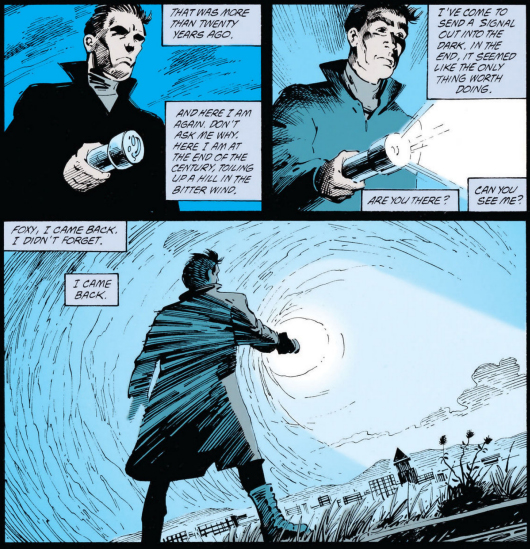
After waiting for a response that doesn't come, Morrison finally walks away, accepting that Foxy never really existed.
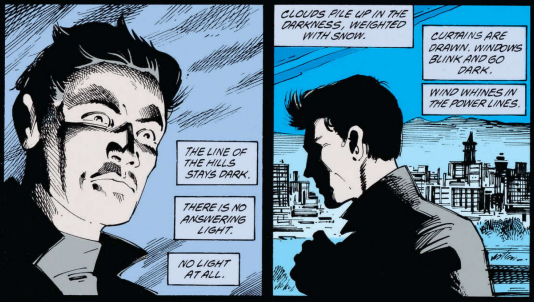
Well, not quite. No, Foxy does not exist in our reality. But this comic takes place in another reality, one of Morrison's creation where he's as real as Morrison wants him to be. Foxy signals back, letting Grant know he's still there.
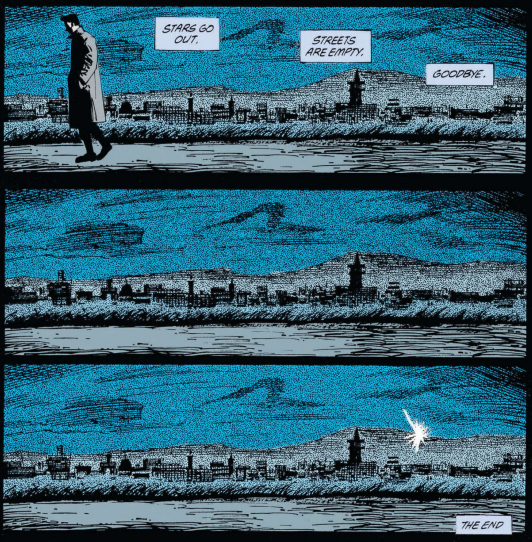
How does Deltarune's credit theme go, again?











